new posts in all blogs
Viewing: Blog Posts Tagged with: Race issues, Most Recent at Top [Help]
Results 26 - 50 of 82
How to use this Page
You are viewing the most recent posts tagged with the words: Race issues in the JacketFlap blog reader. What is a tag? Think of a tag as a keyword or category label. Tags can both help you find posts on JacketFlap.com as well as provide an easy way for you to "remember" and classify posts for later recall. Try adding a tag yourself by clicking "Add a tag" below a post's header. Scroll down through the list of Recent Posts in the left column and click on a post title that sounds interesting. You can view all posts from a specific blog by clicking the Blog name in the right column, or you can click a 'More Posts from this Blog' link in any individual post.

By:
Jason Low,
on 7/29/2014
Blog:
The Open Book
(
Login to Add to MyJacketFlap)
JacketFlap tags:
diversity,
LGBT,
Native American,
Science Fiction/Fantasy,
African/African American Interest,
whitewashing,
Race issues,
Multiracial,
Middle Eastern,
Asian/Asian American,
Latino/Hispanic/Mexican,
The Diversity Gap,
Diversity, Race, and Representation,
Guest Blogger Post,
Add a tag
Summer blockbuster season is in full swing. For many moviegoers, that means escaping to a galaxy far, far away—or perhaps just a different version of our own planet Earth—through science fiction and fantasy movies. As fans clamor for the latest cinematic thrills, we decided to focus our next Diversity Gap study on the level of racial and gender representation in these ever-popular genres that consistently rake in the big bucks for movie studios. We reviewed the top 100 domestic grossing sci-fi and fantasy films as reported by Box Office Mojo. The results were staggeringly disappointing, if not surprising in light of our past Diversity Gap studies of the Tony Awards, the Emmy Awards, the children’s book industry, The New York Times Top 10 Bestseller List, US politics, and the Academy Awards, where we analyzed multi-year samplings and found a disturbingly consistent lack of diversity.
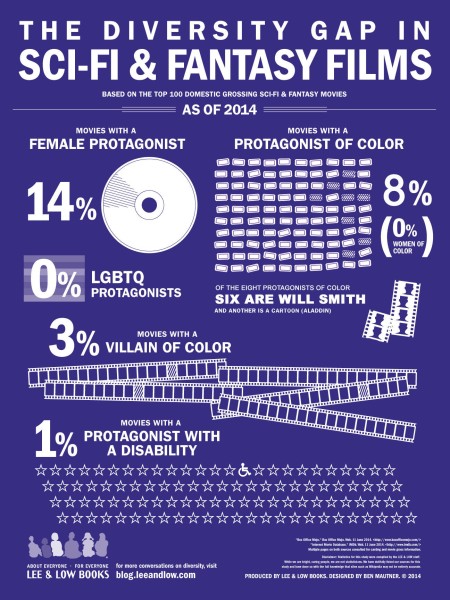
The Diversity Gap in Sci-Fi & Fantasy Films infographic (click for larger image)
Among the top 100 domestic grossing films through 2014:
• only 8% of films star a protagonist of color
• of the 8 protagonists of color, all are men; 6 are played by Will Smith and 1 is a cartoon character (Aladdin)
• 0% of protagonists are women of color
• 0% of protagonists are LGBTQ
• 1% of protagonists are people with a disability
The following interviews with two prominent entertainment equality advocacy groups shed more light on the subject.

Marissa Lee is co-founder of Racebending.com, an international grassroots organization of media consumers who support entertainment equality. Racebending.com advocates for underrepresented groups in entertainment media and is dedicated to furthering equal opportunities in Hollywood and beyond.

Imran Siddiquee is Director of Communications at the Representation Project, which is a movement that uses film and media content to expose injustices created by gender stereotypes and to shift people’s consciousness toward change. The Representation project was the follow-up to the critically acclaimed documentary Miss Representation.
Jason Low: Do these statistics surprise you? Why or why not?
Marissa Lee: The statistics are certainly striking, especially since sci-fi and fantasy belong to a genre that prides itself on creativity and imagination. These statistics aren’t necessarily surprising, since lack of diversity in Hollywood films is a well-known problem. There have been enough studies and articles, and any moviegoer can pause to notice there is a disparity. . . . Hollywood can’t go on pretending that this isn’t a problem.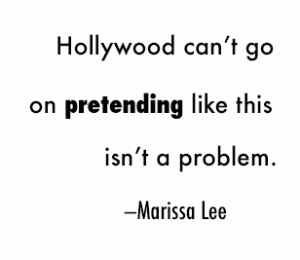
JL: Do you think the American movie-going audience would support a big, blockbuster sci-fi/fantasy movie with a diverse protagonist if a studio made it?
Imran Siddiquee: Yes, definitely. But I think an important thing to understand about Hollywood blockbusters is that they are almost never flukes; they are preordained. Sure, we have the occasional surprise indie hit, but you need a lot of money and marketing behind you to become a blockbuster. Just look at the top ten films in each of the last five years: nearly every single one had a budget of more than $100 million (a lot of them were also sci-fi/fantasy films).
Meanwhile, there hasn’t been a single film released this year starring a person of color with a budget of more than $50 million, let alone a sci-fi film, which is naturally going to be more expensive. The same goes for most of the last decade. So for anyone who might say “people just don’t watch sci-fi movies starring people of color,” or “there’s no evidence that this would work,” the truth is that we have no evidence that it wouldn’t work.
Studios take a couple of massively expensive chances every year on mostly unknown actors or directors—aka giving the Spider-Man franchise to Marc Webb and Andrew Garfield in 2012—but they just don’t take those kinds of chances on people of color. In other words, if Hollywood wanted to make a blockbuster sci-fi/fantasy film starring a woman of color, they definitely could.
ML: I think American audiences would support a film with a diverse protagonist, because we already have. One pullout statistic from your infographic is that Will Smith leads six of the top 100 big sci-fi/fantasy films. His race wasn’t a huge impediment to box office success and may have, in fact, been part of what made him all-American and relatable. That was back in the late 1990s, but since then, Hollywood hasn’t tried to find a new Will Smith. This is kind of ironic, given that Hollywood likes to stick to formulas and sequels! They could push forward another actor—or actress—of color with Smith’s charisma. They haven’t.
The American movie audience supports any movie that Hollywood successfully markets well, especially—but not always—if the film is well produced. Hollywood has managed to market some weird stuff, like a tentpole movie about talking teenage turtle martial artists, or cars that change into space robots, and so on. I don’t buy that when it comes to marketing diverse leads, suddenly this giant industry can’t do it.
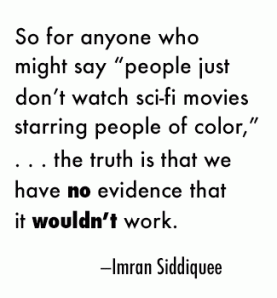 I’d be interested in seeing how many of these top 100 grossing sci-fi and fantasy films star non-human leads. I wonder if there are more films with non-human leads than minority human leads on the list!
I’d be interested in seeing how many of these top 100 grossing sci-fi and fantasy films star non-human leads. I wonder if there are more films with non-human leads than minority human leads on the list!
(Side note: Does the infographic count Keanu Reeves as white or as a person of color? I think he has more than one movie on this list given The Matrix trilogy…)
Editorial note: Yes, Keanu Reeves is counted as a PoC and did make the list for The Matrix. The second Matrix film, The Matrix Reloaded was the only installment of the trilogy to make the top 100 list.
JL: What challenges have you faced or seen peers facing as a woman/person of color, etc.?
ML: There are films with built-in audiences that Hollywood still insists on whitewashing, which has a very adverse effect on actors of color. Let’s be honest, audiences would have still flocked to see The Hunger Games or Twilight if characters like Katniss or Jacob had been cast with people of color as they were written in the books. An actor with a disability could have played the protagonist in Avatar—if we have the technology and imagination to animate a fanciful world populated by blue cat people, we could have cast an actor with a disability similar to the lead character’s in that role. As a result of these casting decisions, up and coming actors from underrepresented groups were deprived of career exposure from being a part of these established franchises, making it harder for Hollywood ever to try and launch a new franchise with an actor from an underrepresented group.
Every single Marvel Studios movie has centered around a presumably straight, white, male protagonist, even if white women (mostly love interests) and men of color (support roles) have played roles in the film. The franchise is a box office juggernaut and has a ton of movies on this list, but we’ve gotten two to three movies about each of the men on the Avengers and there’s yet to be a film about Black Widow. Both of Marvel’s ensemble films—The Avengers and Guardians of the Galaxy—trimmed down the superhero teams for their film adaptations, and the women characters, save for one, were the first to be cut. Most moviegoers will never know that women of color and LGBTQ characters were cut from Guardians of the Galaxy, but audiences will get to relate to the talking raccoon and the talking tree.
More recently, the Divergent franchise cast Naomi Watts to play a character who was a woman of color in the books. It’s a supporting role for an already established franchise, and for whatever reason the production still couldn’t bring themselves to cast an actor of color.
Trends that fans have noted in the media include that in big blockbuster sci-fi and fantasy films, the presence of a straight, white, able-bodied, cis male in some central role in the story is almost guaranteed, while the presence of characters with “minority” identities (e.g. LGBTQ folks, people of color, people with disabilities, women, etc.) is not. Even when a character who isn’t a straight, white cis male is centered in a story, there’s probably a straight, white, cis male character playing second, if not lead, billing. For example, while we can reasonably assume that the next few Star Trek and Star Wars movies will have some diverse characters, we can guarantee that at least one of the leads will be a straight, white man. If The Hunger Games or Twilight had cast actors of color for Katniss or Jacob, there would still have been plenty of lead roles filled by white actors. DC is including Wonder Woman in an upcoming movie, but the film will also feature Batman and Superman.
This means that someone with a lot of intersecting privileged identities (especially straight, white men) will always be able to walk into a multiplex and find a sci-fi/fantasy movie starring someone who shares those identities. If you have a lot of marginalized identities, then representation is a sometimes thing, never a solid guarantee. There is a very small but vocal minority of people who want to maintain this status quo, and Hollywood seems to cater toward them due to institutionalized racism, fear, and habits. But there are just as many, if not more, people who are willing to support, vociferously, films with diverse leads. I wish our money was as good as theirs.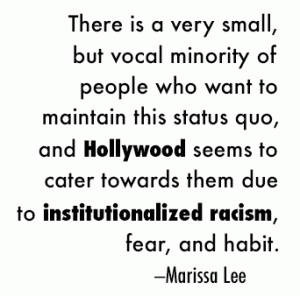
JL: How can consumers encourage more diversity in movies?
IS: Avoid buying tickets to films which clearly rely on stereotypes or demeaning portrayals of people based on gender, race, class, age, sexual orientation, ability, or circumstance. And anytime you do watch a film, give it The Representation Test afterward. The test grades films on their inclusiveness pertaining to all those above categories. When a movie scores really low on the test, use #NotBuyingIt on Twitter to let the filmmakers and all your friends know how you feel. Since so much of this industry is based on money, this is one way we can express our discontent and get the attention of the studios.
ML: Media literacy is a huge start. As media consumers, we should feel empowered to critique the media we consume, and to decide what media we choose to consume. Beyond helpful steps like going to see movies that feature diverse leads, it’s just as important to start conversations in our own communities and with our friends and family (the people we consume media with!) to raise awareness about diversity and representation. Even if we don’t go to see movies that whitewash or exclude or present discriminatory content, people we know will. One way we can help change things is by continuing to start conversations. We need to create an environment where it is safe to criticize popular franchises for lacking diversity. We also need to keep drowning out the malcontents who cannot even handle actors of diverse backgrounds in supporting roles. Social media has really knocked down barriers when it comes to communicating our opinions with Hollywood brass. It’s also given us several spaces where we can discuss the media we consume with our friends and family. In addition, the internet has really changed how we access and consume media. There are Kickstarters and indie channels and online comics and other outlets so we don’t have to be reliant on big production studios or publishers as our only sources of entertainment.
JL: How close or far do you think we are from getting these statistics to change?
IS: When you’re talking about representation that is this low, it’s hard to go anywhere but up. For instance, 0% for women of color in top sci-fi films means I’m being honest when I say things will certainly improve soon, but that’s not saying much. I think we are pretty far away from true equality, or a cinema that reflects and includes the broad diversity of human experiences in the real world.
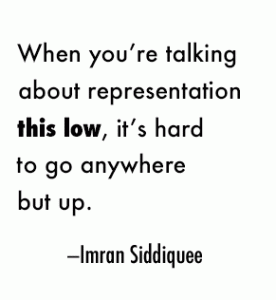 Too many wealthy, white men still run Hollywood, and their decisions still have too much power. As I mentioned earlier, these kinds of movies are very expensive, and so it’s hard for independent or upstart filmmakers to break through or compete.
Too many wealthy, white men still run Hollywood, and their decisions still have too much power. As I mentioned earlier, these kinds of movies are very expensive, and so it’s hard for independent or upstart filmmakers to break through or compete.
That being said, the slight increase in success for white women in blockbuster sci-fi movies, such as Gravity, The Hunger Games, and Divergent, means change is possible. And it’s hard to overstate the importance of the Oscar wins for 12 Years a Slave last year, because while it wasn’t a blockbuster, it is a film that everyone in the industry now knows about and has probably seen. And the whole reason we’re even talking about representation in movies right now is because we know how much seeing different experiences on screen can impact people’s real world thoughts and attitudes. So films like 12 Years a Slave are part of the gradual shifting of consciousness that has to happen in Hollywood to get to a point where studios are consistently greenlighting big-budget films starring people of color.
ML: As budgets for tentpole science fiction and fantasy movies have soared, studios have been more reluctant to take a chance on actors or characters that they perceive as risks. Because people of color and women are also already more likely to consume movies than white people and men, maybe they don’t feel an incentive to change what they are doing because, from their perspective, minorities are perfectly willing to watch films starring white guys. Hollywood is pretty stubborn, especially when it comes to tentpole movies. We are seeing more diversity in television, particularly in children’s television, as well as in online content. The establishment will change when someone influential in Hollywood decides to take the risk and make an effort to diversify their film offerings. The stats in this infographic are focused on profit, not art. For things to change, Hollywood needs to believe that diversity can be profitable.
***
This is not an isolated incident, but a wide reaching societal problem.
Read more Diversity Gap studies on:
The Academy Awards
The Tony Awards
The Emmy Awards
The children’s book industry
The New York Times Top 10 Bestseller List
US politics
Further resources on how to teach content and visual literacy using Lee & Low Books’ infographics series on the Diversity Gap:
Using Infographics In The Classroom To Teach Visual Literacy
CONTACT: For more information or to request permission to reprint, please email hehrlich[at]leeandlow[dot]com
Filed under:
Diversity, Race, and Representation,
Guest Blogger Post,
The Diversity Gap Tagged:
African/African American Interest,
Asian/Asian American,
diversity,
Latino/Hispanic/Mexican,
LGBT,
Middle Eastern,
Multiracial,
Native American,
Race issues,
Science Fiction/Fantasy,
whitewashing 


By:
jilleisenberg14,
on 7/27/2014
Blog:
The Open Book
(
Login to Add to MyJacketFlap)
JacketFlap tags:
Race issues,
Multiracial,
Educator Resources,
Diversity, Race, and Representation,
Reading Aloud,
reading comprehension,
children's books,
diversity,
Educators,
Add a tag
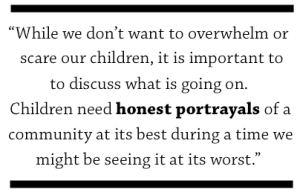 Breaking stories, developing crises, and unexpected catastrophes often involve more than one country, community, and culture. As our children listen in to the radio while stuck in traffic or the evening news program over dinner, it can be easy to think that if we don’t explicitly bring up the news story, then our children don’t know it’s happening.
Breaking stories, developing crises, and unexpected catastrophes often involve more than one country, community, and culture. As our children listen in to the radio while stuck in traffic or the evening news program over dinner, it can be easy to think that if we don’t explicitly bring up the news story, then our children don’t know it’s happening.
In fact, children are incredibly perceptive when their parents and adults close to them are distracted by news or alarming events. Many children also pick up information from their peers.
While we don’t want to overwhelm or scare our children, it is important to discuss what is going on. Children need honest portrayals of a community at its best during a time we might be seeing it at its worst.
How do we talk to children about these events and use these moments as opportunities to have respectful, honest (albeit age-appropriate) discussions?
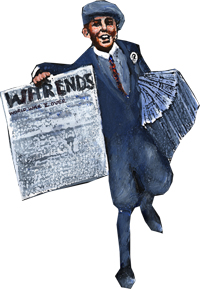
Picture books are invaluable conversation starters. Conflicts and disasters have complex origins and multiple players. Issues of race, class, religion, and gender are often entangled in the events or portrayal of the events. Children’s books dealing with conflict or natural disasters can frame the event in contexts and meanings suitable to their developmental stage. Stories with children as the main characters allow children to identify with the characters over universal themes.
When a “newsworthy” event happens, this may be the first time the child learns of this country, group of people, or culture. By the same token, the conflict or event may involve the child’s own heritage or culture. Using picture books to talk about a current event or conflict can be an opportunity to learn about a new region and help children see the culture and people beyond this event.
Instead of allowing the media to define the group of people involved, we should seek out and read a book showcasing and reinforcing the positive aspects and pride of the featured group of people and region. In doing so, we present a broader perspective of the community, culture, or people that media coverage is portraying in a negative, humiliating, or victimized light.
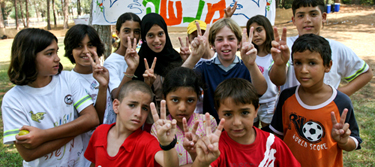
In selecting the right book to foster respect and provide an honest portrait of a community in the news, consider:
Books that champion human dignity:
Books that exhibit the strength, courage, and resilience of children:
Books that depict a community’s capacity to endure, love, and give:
“Age-appropriate” can mean truthful, thoughtful conversations. When talking to children, let them guide the discussion. Opening conversation starters include: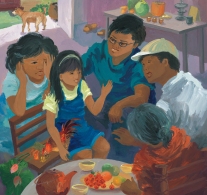
- What questions do you have? What have you heard?
- What do you know about the situation or group of people/foreign country involved?
- Who are the countries or communities involved?
- How are different communities and countries coming together over this issue?
- What would you like to do to help?
For further reading:
 Jill Eisenberg, our Resident Literacy Expert, began her career teaching English as a Foreign Language to second through sixth graders in Yilan, Taiwan as a Fulbright Fellow. She went on to become a literacy teacher for third grade in San Jose, CA as a Teach for America corps member. She is certified in Project Glad instruction to promote English language acquisition and academic achievement. In her column she offers teaching and literacy tips for educators.
Jill Eisenberg, our Resident Literacy Expert, began her career teaching English as a Foreign Language to second through sixth graders in Yilan, Taiwan as a Fulbright Fellow. She went on to become a literacy teacher for third grade in San Jose, CA as a Teach for America corps member. She is certified in Project Glad instruction to promote English language acquisition and academic achievement. In her column she offers teaching and literacy tips for educators.
Filed under:
Diversity, Race, and Representation,
Educator Resources Tagged:
children's books,
diversity,
Educators,
Multiracial,
Race issues,
Reading Aloud,
reading comprehension 

 Sarah Hannah Gómez has an MA in children’s literature and an MS in library and information science from Simmons College. Currently
Sarah Hannah Gómez has an MA in children’s literature and an MS in library and information science from Simmons College. Currently  she works as a school librarian in Northern California. An aspiring novelist and screenwriter, she is passionate about social issues in literature and social media engagement with books. She spends the rest of her free time singing, reading, and learning to run. Visit her blog at http://mclicious.org.
she works as a school librarian in Northern California. An aspiring novelist and screenwriter, she is passionate about social issues in literature and social media engagement with books. She spends the rest of her free time singing, reading, and learning to run. Visit her blog at http://mclicious.org.
I was going to start this post with something pithy like, “How to survive the apocalypse: Be white. Or Morgan Freeman. Or, 2012 onwards, be a Kravitz!” I was going to tell you how dystopian and post-apocalyptic fiction and film allow creators to act out a future and explore countless possibilities that could ruin or save the world. And that is kind of what’s happening, though it’s a lot more complicated than that…
Have you noticed that every movie trailer that talks about Earth after some catastrophic event displays a civilization of white people (and 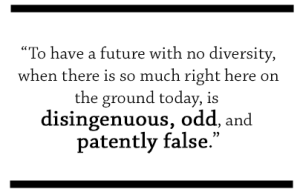 Morgan Freeman) speaking American English? Sure, some of that is unavoidable and practical–you can’t make a movie about everyone and in every language at the same time–but it’s also ethnocentric and exceptionalist of us. Not to mention problematic in myriad ways, because the lack of diversity goes utterly unacknowledged.
Morgan Freeman) speaking American English? Sure, some of that is unavoidable and practical–you can’t make a movie about everyone and in every language at the same time–but it’s also ethnocentric and exceptionalist of us. Not to mention problematic in myriad ways, because the lack of diversity goes utterly unacknowledged.
Generally in dystopia, the reader understands everything about the society in the story as a copy of their own, except when the author specifically points out the rules that make it different. So to have a future with no diversity, when there is so much right here on the ground today, is disingenuous, odd, and patently false.*
As it’s the United States that is driving the current success of dystopian genre, let’s look specifically at o
ur diversity. White people will no longer be the majority within thirty years, says the Brookings Institution. And in the meantime, people of color are rising to positions of power (hey, Obama!) all over, and while we have a long way to go, old bastions of whiteness and power are being dismantled. While I can’t say this from experience, since I’m a woman of color, I can imagine that this is terrifying to people who are in a position to lose their power. If I were someone with lots of privilege and power, I would want to hold onto it, and it would be very nice to create a world in which I could.
If you look at it that way, you can see why it’s so popular to whitewash the future. A dystopian world is the ultimate controlled environment, so why not control the things you fear, like losing your power or sharing it with people different from you?
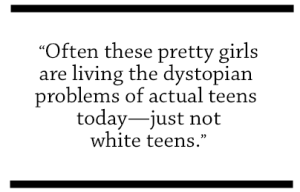 The Hunger Games goes the route of having a nearly white world with the usual Noble Savage (Thresh) and Magical Negro (Rue) to guide and humanize the protagonist and ultimately sacrifice themselves for her. For all that it’s a classic that works very well, The Giver talks about how Jonas only begins to see color when he sees Fiona’s hair, but there is never any mention or questioning of skin tones and what they might mean, though all sorts of interesting “post-racial” ideas could come out of such a discovery. Countless other dystopias, like the Eve series, Crewel, and so many that have combined in my head, star pretty white girls who have the problems that come with having long, flowing hair and yet being physically strong and adorably unaware that everyone is in love with them.
The Hunger Games goes the route of having a nearly white world with the usual Noble Savage (Thresh) and Magical Negro (Rue) to guide and humanize the protagonist and ultimately sacrifice themselves for her. For all that it’s a classic that works very well, The Giver talks about how Jonas only begins to see color when he sees Fiona’s hair, but there is never any mention or questioning of skin tones and what they might mean, though all sorts of interesting “post-racial” ideas could come out of such a discovery. Countless other dystopias, like the Eve series, Crewel, and so many that have combined in my head, star pretty white girls who have the problems that come with having long, flowing hair and yet being physically strong and adorably unaware that everyone is in love with them.
Not only is this a tired trope overall, but often these pretty girls are living the dystopian problems of actual teens today–just not white teens—
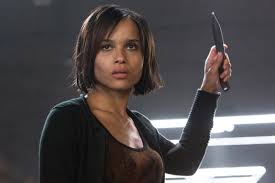
Christina from Divergent
so it seems a missed opportunity to do what dystopia does best: safely explore and criticize a contemporary problem in a made-up place. Adelice in Crewel is snatched from her family in order to be trained to be a useful member of society and told she can’t associate with her relatives anymore, which sounds like the experience many Native American children had in the twentieth century when they were sent to schools tasked with making them less “savage.” And before she’s whisked away, her parents encourage her to fail the test that ultimately makes her become a Spinster. I can see a lot of parallels with the way members of minority groups must carefully balance their membership in their ethnic group with their membership in their class group, especially if their socioeconomic class does not match the one traditionally associated with their ethnic group.
Otherwise harmless and fun books like The Neptune Project attempt to have a diverse supporting cast, but fail when examined beyond a superficial level. Sentences like “I realize that he looks Asian” are awkward and technically meaningless. Pointing out a specific characteristic first and foremost, while never starting off that way when meeting a new person who is white, perpetuates the assumption that white is the default, the “normal” from which all other humans deviate.
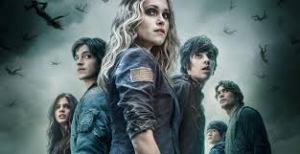
Image from The 100
Visual representation in films set in the future is also important, and in some ways improving. In Veronica Roth’s book Divergent, Tris’s best friend Christina is black, and she remained so in the film, where Zoë Kravitz played Christina alongside two other actors of color in significant speaking roles. The CW’s new TV show The 100, based on Kass Morgan’s book, has two black characters and other actors of color.**
However, in both worlds, everyone is essentially raceless. This could be considered progressive in some ways–they just live normal human lives, as people of color are sometimes observed to do in nature. But it is problematic in others. Does race really not impact these characters’ lives in any way? How can a society be at once so peaceful and advanced as to be post-racial and yet be so broken that it needs teenagers to dismantle its entire structure (Divergent) or rebuild its world (The 100)?
The 100 misses a huge opportunity to do more with race and ethnicity–its premise, that juvenile delinquents are sent to re-colonize Earth the way convicts were sent to Australia, could allow for an exploration of how incarcerated youth in our world today are disproportionately black and brown. Instead, nearly every member of the 100 is white.
I’m not saying there’s nothing good out there. The Summer Prince, by Alaya Dawn Johnson, is set in futuristic Brazil, stars teens and adults of various shades of brown, is a veritable queer utopia, and allows both its characters and its readers to grapple with complex questions about technology and ethics without coming to one conclusion. But even after making the National Book Award longlist, it was ignored by ALA in all of its awards, and it’s not getting nearly the amount of recognition it should be getting, neither for its literary quality nor for its progressive strides.
of various shades of brown, is a veritable queer utopia, and allows both its characters and its readers to grapple with complex questions about technology and ethics without coming to one conclusion. But even after making the National Book Award longlist, it was ignored by ALA in all of its awards, and it’s not getting nearly the amount of recognition it should be getting, neither for its literary quality nor for its progressive strides.
Still, we seem to be on the cusp of something different when it comes to diversity in science fiction. Then again, The Cusp tends to be when people about to lose power get more aggressive about what they’re about to lose, so we could be on our way to much better or much worse. It will be interesting to watch. And read.
*However, were an author to acknowledge the blinding whiteness with a backstory about white supremacy where only the white people were allowed on the spaceship or inoculated against the great plague, that could be a fascinating read, actually.
**Though we’ll see if Henry Ian Cusick’s character ever gets to allude to the actor’s Latino heritage.
Looking for diversity in your dystopias? Try these:
Diverse Energies
The Tankborn trilogy
Killer of Enemies
Or check out this list of dystopias featuring diverse characters.
Filed under:
guest blogger,
Tu Books Tagged:
diverse YA,
dystopia,
race in entertainment,
race in TV,
Race issues,
Tu Books 


By:
jilleisenberg14,
on 2/26/2014
Blog:
The Open Book
(
Login to Add to MyJacketFlap)
JacketFlap tags:
History,
diversity,
Oscars,
Educators,
reading comprehension,
infographics,
Academy Awards,
Race issues,
common core standards,
CCSS,
visual literacy,
teaching about race,
Curriculum Corner,
ELA common core standards,
Add a tag
 Jill Eisenberg, our Resident Literacy Expert, began her career teaching English as a Foreign Language to second through sixth graders in Yilan, Taiwan as a Fulbright Fellow. She went on to become a literacy teacher for third grade in San Jose, CA as a Teach for America corps member. She is certified in Project Glad instruction to promote English language acquisition and academic achievement. In her column she offers teaching and literacy tips for educators.
Jill Eisenberg, our Resident Literacy Expert, began her career teaching English as a Foreign Language to second through sixth graders in Yilan, Taiwan as a Fulbright Fellow. She went on to become a literacy teacher for third grade in San Jose, CA as a Teach for America corps member. She is certified in Project Glad instruction to promote English language acquisition and academic achievement. In her column she offers teaching and literacy tips for educators.
Infographics’ format and economy of words make infographics engaging and accessible to children, reluctant readers, visual learners, and English Language Learners. As infographics contain multiple layers of information, they are a challenging medium for students to practice inferences and interpretation. Lee & Low Books’ infographic series on the diversity gap in major spheres of influence is a valuable vehicle to build students’ visual literacy skills and understanding of diversity. The following discussion questions and suggested activities were created based on the Diversity Gap in the Academy Awards infographic, but these can be applied to the rest of the series.
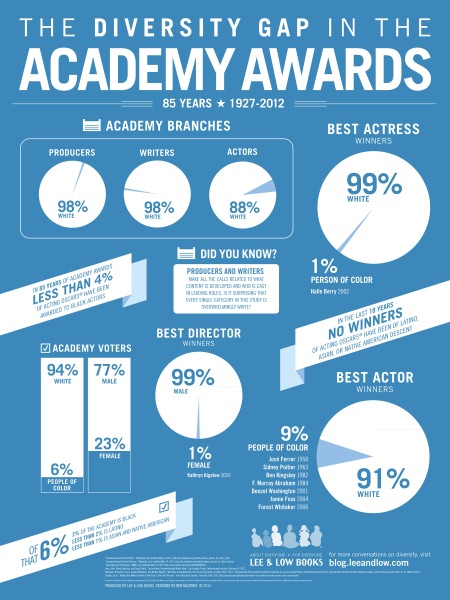
Infographic: The Diversity Gap in the Academy Awards (click to enlarge)
Discussion questions to consider with your students:
- What patterns do you see? What trends do you see? How are the different charts related?
- What is the central idea of this infographic? How do the words, phrases, and visuals interact to affirm the central idea?
- Based on the infographic, what does “diversity gap” mean in terms of the Academy Awards?
- What might the author’s purpose be in choosing this medium to convey the central idea (to shame, inspire, shock, etc.)?
- Does the infographic make the central idea clear and obvious? How does the infographic use an economy of words, language, typography, pie charts, bar graphs, negative space, and title to communicate the central idea?
- What type of infographic is this (flow chart, web, map, graph, diagram, table, timeline)? What might the author’s purpose be in choosing this type of infographic? How effective is this format of infographic at organizing and displaying data compared to just text?
- Evaluate the effectiveness of the infographic as a form of communication as compared to text alone. Is this the most effective and convincing way to convey information about a lack of diversity at the Academy Awards? Why or why not?
- Why might the creators have assembled this information about the Academy Awards and race at all?
- Who is the intended audience (moviegoers, actors, directors, writers, producers, movie studios, general public, government officials)? What might the creators of this infographic want them to do with this information?
- What is the context of this infographic? What major events in the United States were taking place when this infographic was created? Why is it important to understand the context of the infographic?
- Is this infographic’s argument and presentation persuasive or compelling? Why or why not? Analyze this infographic’s effectiveness in inspiring activism.
- Based on the information presented, what can you predict future trends will be for award winners, actors, directors, producers, and writers?
- Can you determine causes for the lack of diversity in this infographic? Why or why not? How might researchers go about figuring out the cause(s) for the historical and current lack of diversity in the Academy Awards?
- What is the impact of a lack of diversity amongst writers, actors, producers, directors, and award winners? What does it mean to be a young child growing up and consuming this form of media (movies)? What will they see? What will they not see? Tell me more about the possible effects of this situation and current trends.
Suggested activities:
- Challenge students to translate this infographic’s central idea into a written argument. Students should use key details and evidence from the infographic to assert the central idea.
- Have students revise or add on to make the infographic more effective. Students should consider format, adding or deleting information, and more. What would make the infographic stronger, more persuasive, or more memorable?
- Encourage students to investigate how these percentages compare to the general public. Students can use the United States Census data for demographics.
- Have students investigate possible causes for the lack of diversity in the Academy Awards. Urge students to propose ways to change these trends.
- If possible, ask students to research the percent of moviegoers who are people of color. Check industry publications or major news periodicals. How do these numbers compare to the information in the infographic?
- Permit students to interview their grade, class, or school on questions, including: Do you go to the movies? How often? What kinds of movies do you see? Who are your favorite actor and actress in Hollywood today? Who is a director/actor/actress of color that you have seen in a movie recently? Why do you think there aren’t more movies by and with people of color? Students can organize and display data in graphs and present findings to the class. Reflect on this information’s relationship to the infographic’s central idea.
- Dig deeper—investigate the artists that were nominated each year. How many were people of color over those 85 years? What roles did these artists play in the movies they were nominated for? What genres of movies were they in for this nomination? Explore the people of color who did win best actress or best actor. What roles did they play and what kind of movies were they in when they won for best acting?
- Compare this to other Lee & Low Books’ infographics in the series: The Tony Awards, The Emmy Awards, Children’s Book Publishing, The NY Times Top 10 Bestsellers List, and American Politics. Consider central idea, evidence, format, and audience.
- Update the information to include the 2013 and 2014 Academy Awards results. What changed? What did not change?
For further reading on teaching visual literacy and diversity in the classroom, check out these fantastic resources:
How are you building visual literacy skills in the classroom? Let us know below!
Filed under:
Curriculum Corner Tagged:
Academy Awards,
CCSS,
common core standards,
diversity,
Educators,
ELA common core standards,
History,
infographics,
Oscars,
Race issues,
reading comprehension,
teaching about race,
visual literacy 


By:
Jason Low,
on 9/18/2013
Blog:
The Open Book
(
Login to Add to MyJacketFlap)
JacketFlap tags:
Emmy Awards,
Race issues,
Multiracial,
Middle Eastern,
Latino/Hispanic/Mexican,
The Diversity Gap,
History,
diversity,
guest blogger,
Native American,
African/African American Interest,
Add a tag
Publishing diverse children’s books for more than two decades has given us a unique perspective when it comes to diversity. While our mission is to bring more diverse books to children, we hope our efforts as activists keep the wider conversation on race and inequality in the spotlight. Our previous Diversity Gap studies on the Tony Awards and the children’s book industry revealed a disturbing trend in ethnic and gender representation. We decided to focus on the television industry next.

Emmy Awards infographic (click for larger image)
Our Diversity Gap study on the Emmy Awards was the logical choice for objectively looking at the small screen. Since the Emmys will be presented on September 22, 2013, we collected data to see if a diversity gap exists in television. See our infographic above for Emmy related facts like:
- No woman of color has ever won an Emmy Award for Best Actress in a Drama Series
- In the last twenty years, winners in the Best Director of a Comedy Series were 100% white and 95% male
- An African American woman has not been nominated for lead actress in a Comedy Series since The Cosby Show (1986)
We implemented the methodology we have used previously, with the help of the Writer’s Guild of America West, and we were fortunate to have the opportunity to speak with two talented writer/actors. Their combined insights into the mechanism behind making television illuminate why the lack of diversity in casting and writing remains a very real, very complex problem.

Luisa Leschin definitely believes in the richness of diversity. She has enjoyed four very successful careers: ballet dancer, actress, voice-over artist and television script writer. Her writing credits include The George Lopez Show and Everybody Hates Chris. She is currently developing a children‘s sitcom pilot with EOne Entertainment with a theme of healthy living and is writing a pilot about Latino millennials called Homies.
 Kelvin Yu is a Taiwanese-American writer currently working on the Fox animated series Bob’s Burgers. A Los Angeles native, Yu studied theater and communications at UCLA. His acting credits include Milk, Star Trek, Studio 60 On The Sunset Strip, and The Shield. He also has a small white dog named Yuki who used to live in New York. Neither of them are fixed.
Kelvin Yu is a Taiwanese-American writer currently working on the Fox animated series Bob’s Burgers. A Los Angeles native, Yu studied theater and communications at UCLA. His acting credits include Milk, Star Trek, Studio 60 On The Sunset Strip, and The Shield. He also has a small white dog named Yuki who used to live in New York. Neither of them are fixed.
Luisa, what types of roles were you being cast for when you were an actress?
LL: I was lucky enough to be a working actress during the 1980s and early 1990s. I started my career in New York, where I studied with Uta Hagen, a legendary actress and teacher. I speak un-accented English, but judging from my auditions, I soon realized that I better work on my Mexican, Cuban, Guatemalan, Colombian, and Puerto Rican spitfire accents because those were the only roles for which I was being considered. I remember walking onto the set of Hill Street Blues, where I was playing the pregnant girlfriend of a gang member. We had just been arrested. My fellow “actor” introduced himself to me and asked me how many times I had been arrested, because he’d been arrested twice! Toward the end of my on-camera career, I did a “role-count” and discovered that I had played a pregnant woman (in various stages of delivery) no less than six times, hookers, maids, gang-girlfriends, and as I got older, gang-girlfriend’s mothers . . . and not much else.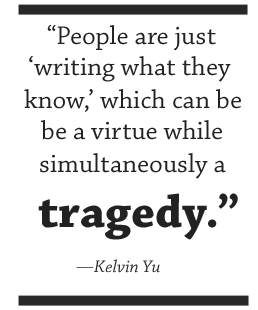
Kelvin, in our initial conversation you said you felt that as an actor you have resigned yourself to always playing second banana—that you would never appear as a main character in a TV show. You attributed this to a standard of beauty. Could you elaborate on this for us?
KY: I may have used the word “resigned” but I think, more accurately, as an Asian American actor you just come to understand the market place as it is. That’s not to say that you don’t hope it could someday change, but you understand that American audiences are not generally even ready for a female lead most of the time, so it is unlikely they will mass-consume a television show or a studio feature with an Asian American carrying the story. That said, this year we’ve seen Mindy Kaling and Ken Jeong take on huge projects that are viewed by millions of people. But these are, of course, the exception rather than the rule.
As I said before, it’s not entirely an issue of race either. I don’t think Dan Devito had any illusions in Romancing the Stone that he was gonna get to kiss Kathleen Turner. The paradigm of the American hero is, in the main, a handsome white dude, say, six feet tall—and that’s just how it is. I truly feel though, at the end of the day, audiences are going to connect with the best storytelling. We’ve seen that movie goers will champion protagonists in every shape, color, or form (even a talking pig!) if the storytelling is honest and resonant. So in some ways, I just challenge Asian American writers, producers, and directors to introduce great stories that feature different types of protagonists. It wouldn’t be fair or realistic to charge other people to tell your stories. People are just “writing what they know,” which can be a virtue while simultaneously a tragedy.
Luisa, you founded the comedy troupe Latins Anonymous. Tell us the goal of Latins Anonymous and how this led to you become a writer.
LL: The resulting frustration of having a demo reel that was a hit parade of stereotypes led me to join forces with three other Latino actors who were in the same boat. We knew that as actors we were powerless to effect change from the stage. We just didn’t have the voice to do it. The real power came from higher up—the writers and producers. So that’s why I embarked on a writing career, to help change how Latino roles were written and perceived, and also just to get more Latino actors in front of the camera. Ironically, this move pretty much killed my acting career because casting directors who came to see our show skewering stereotypes were too embarrassed to offer us those same stereotypical roles.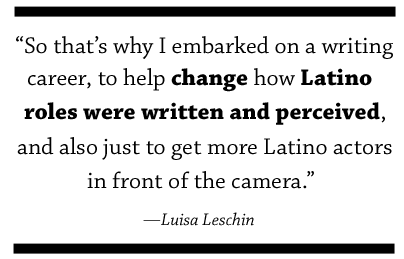
Kelvin, you attended college at UCLA, where the number of Asians make up 49% of the student population. Yet you mentioned that you are the only person of color in a thirteen person writing team. Why doesn’t the density of Asians living and working in Southern California amount to a larger representation of Asians in decision-making roles in TV?
KY: Don’t know. I know for a FACT that Asian Americans love to consume media—movies, television, video games, social media, all of it—so their lack of representation over the past several years is probably a combination of factors including cultural emphasis in different fields, a lack of avenues within the industry, and some level of systemic prejudice (particularly in the past).
However, I do think this is about to change big time. I think in the next few years you will see a flood of Asian content creators. Some of that is simply the rapidly closing cultural gap that social media and the internet are facilitating. Young Asian writers and actors and directors are growing up seeing Ang Lee and Justin Lin and Wong Kar Wai and Zhang Yimou win Oscars and BAFTAs. The world, for better or for worse, is remarkably smaller than it was a decade ago and audiences are more open, even hungry, for unique voices. I also think new media renders many of those past obstacles powerless against the thousands of outlets for Asian American creativity. For instance, even if your stern Korean father wants you to become a doctor, he can’t really stop you anymore from making small movies with your iPhone and cutting them with some app. People can write, shoot, edit, and even distribute content from a $300 laptop. How was an Asian American teenager supposed to do that in 1990? Not to make Asian parents seem like the only barrier, and also not to make them seem all like Kim Jong Eun. I just think we’re about to see an influx of new voices and, thus, new stories. Which is very exciting.
Luisa, during our conversation you mentioned “that there is a system” in place to break into writing for television. Describe for us what that system is and what are some of the hurdles involved with addressing the problem of the diversity gap in TV programs.
LL: We all know the famous quote by William Goldman: “In Hollywood, no one knows anything.” And we also know that many roads lead to Rome. . . . So, having stipulated that, I’m talking about the established network system. If you manage to get in on the ground level as a staff writer or story editor and then move up the ladder to senior story editor, producer, co-producer, and ultimately co-executive producer you will then become a known entity to the networks. At this point the powers that be feel confident that you have experienced firsthand about how TV shows are written and run. The network is willing to listen to show ideas from you, willing to consider ordering a pilot from you, because they know you have put in your time working under showrunners they trust and that you have experience on how things are done. This is the path that most showrunners have taken to rise to the position where a network trusts them to run a multi-million dollar show.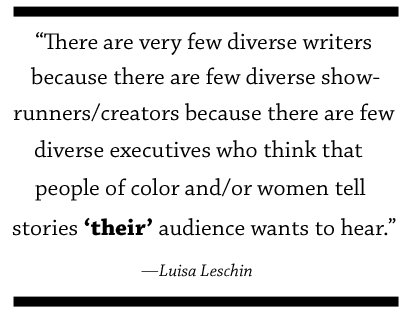
Which brings us to the biggest problem facing us in trying to narrow the diversity gap. There are very few diverse writers because there are few diverse showrunners/creators because there are few diverse executives who think that people of color and/or women tell stories that ”their” audience wants to hear. Certainly there are other ways of breaking into television writing, especially with all the new media platforms, but ultimately there are no shortcuts for putting in the time and learning the workings of television from the bottom up.
Kelvin, what are some of the factors that may keep white writers and producers from taking a chance on casting or writing more characters who are people of color into TV shows?
KY: I honestly think most writers just write what they know. Particularly in TV, which is by definition on a deadline, it’s just not going to be your instinct to pitch a story about a Pakistani family if you have never had any experiences with Pakistani families. Nor do I blame writers and producers for remaining within a personal wheelhouse of stories that reflect their particular vantage point on the world. Every once in a while, you get an Ang Lee or a Coen Brothers—storytellers who find a way to turn something quite foreign to them into something deeply personal. But I think most of us, when given that rare chance to tell a story, want to tell the stories we dreamed of sharing with the world. Our own stories. And that’s okay. That’s not just okay; that’s good. So the issue is, how do we get more eclectic people into the room? How does the face of TV writing start to look more like the face of America?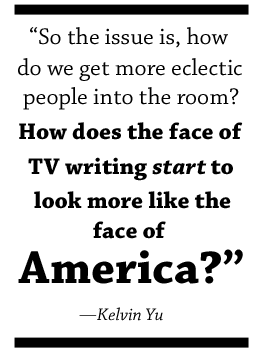
Luisa, you worked on The George Lopez Show, which aired for five seasons. From your description of the system, how did a show like this get made in the first place?
LL: It took a movie star, an established showrunner of multiple hit shows and an exceptional talent. At the time, Sandra Bullock had a development deal at Warner Brothers. Someone told her about stand-up comedian George Lopez and she and showrunner Bruce Helford (Creator of Norm, The Drew Carey Show, and Anger Management) went to see his show. Sandy fell in love with George’s talent and told Warner Brothers this was the show she wanted to develop. It took a lot of pull and star power to get the show on the air.
Everyone always has that one great idea for a pilot. But it’s seldom about the idea. All you have to do is look at most hits on TV. Cosby, a show about a family; Seinfeld, a show about nothing; Friends, six friends sitting on a couch. The salability of a pilot really rides on the team behind it. Who is the talent big enough to carry a show that has broad appeal for middle America? And who will be writing and running the show? This is why the same dozen showrunners get pilot after pilot every season. (Can you say Chuck Lorre? Bill Lawrence?) It’s because they have a track record in the network system and executives know they can deliver a show.
Luisa, you have done considerable work on some successful sitcoms over the years. Are there shows that you have worked on, or actors and actresses, who have been overlooked by the Emmy Awards?
LL: Yes! Every show I have worked on had brilliant actors who should have been at least nominated to receive an Emmy: George Lopez, Constance Marie, Belita Moreno from The George Lopez Show; Terry Cruise, Tichina Arnold, both from Everybody Hates Chris. Too often shows that feature diversity are overlooked by voters of the Academy. I don’t believe it’s any kind of conscious bias. Having been a judge for a few award shows myself, I discovered that I was more favorably inclined to a show if I had already watched the show, if I was familiar with the characters or if I might have already seen the nominated performer or episode. In short, I was already a fan. The sad fact is that most judges in the Academy are not diverse and may not be watching shows that feature diversity and/or diverse characters.
—
One thing worth noting about the 2013 Emmy Awards: Kerry Washington is nominated for best actress in a drama for Scandal. If she wins, she will be the first actress of color to win an Emmy Award for a drama in the sixty-five year history of the award! The fact that she is nominated at all is a testament to Shonda Rhimes’s style of ethnically inclusive casting and writing. Ms. Rhimes is essentially the embodiment of what Luisa Leschin describes as the television system for breaking into writing. Ms. Rhimes worked her way up the ranks, paid her dues, and became a showrunner. Her version of television presents a real world example of what TV shows could look like: ethnically and gender inclusive, entertaining, and . . . successful.
Our Emmy Award study, much like our studies on the Tony Awards and the children’s book industry show that the diversity gap is a widespread, societal problem that we all have a responsibility to fix.
Filed under:
guest blogger,
The Diversity Gap Tagged:
African/African American Interest,
diversity,
Emmy Awards,
History,
Latino/Hispanic/Mexican,
Middle Eastern,
Multiracial,
Native American,
Race issues 


By:
Jason Low,
on 3/13/2013
Blog:
The Open Book
(
Login to Add to MyJacketFlap)
JacketFlap tags:
Middle Eastern,
Asian/Asian American,
Latino/Hispanic/Mexican,
Awards,
Book News,
diversity,
first book,
LGBT,
Native American,
African/African American Interest,
Bellringers,
Race issues,
Multiracial,
Dear Readers,
Add a tag
In a groundbreaking announcement, First Book, a non-profit social enterprise launched the Stories for All Project. The project’s aim is to introduce a significant number of multicultural books into the hands of low-income children. LEE & LOW was chosen as one of two publishers to be a part of this endeavor and receive a $500,000 award.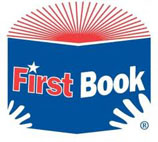
For us the presence of this project further addresses the fact that diverse books are a necessity. Making multicultural books available to low-income families is a step toward addressing the chasm between people who believe these books are important to actually making the books available to the children who need them.
For years I have been involved in conversations with librarians and educators on the subject of how we need more diverse books. However, there is this strange disconnect where people continue to point out the lack of diverse books without doing the most obvious thing, which is supporting the companies that publish these books in the first place. The support is simple. It involves buying the books. It also involves telling people about the books and recommending them to buy the books. The more this happens the more books we can publish.
What First Book has done is monumental in supporting multicultural books. It is a bold statement that I hope is just the beginning. An infusion of this many diverse books increases the chances of a child being able to see a face like his or her own staring back at them from the pages of a book. This moment of recognition for a child will create a profound experience that will be forever associated with the act of reading. This powerful relationship to books is one that they will hopefully cultivate for the rest of their lives.
On behalf of everyone at LEE & LOW I want to thank CEO Kyle Zimmer, Executive Vice President Chandler Arnold, Vice President Erica Perl, along with all the dedicated people working on the Stories for All Project. First Book’s commitment and dedication to literacy and multicultural literature is to be commended. This will be a game changer for many children who will be receiving their very first book ever.
Filed under:
Awards,
Bellringers,
Book News,
Dear Readers Tagged:
African/African American Interest,
Asian/Asian American,
diversity,
first book,
Latino/Hispanic/Mexican,
LGBT,
Middle Eastern,
Multiracial,
Native American,
Race issues 


By:
keilinh,
on 3/12/2013
Blog:
The Open Book
(
Login to Add to MyJacketFlap)
JacketFlap tags:
writing contests,
diversity,
guest blogger,
Science Fiction/Fantasy,
Power of Words,
Musings & Ponderings,
Race issues,
Tu Books,
Teens/YA,
promoting diversity,
New Visions Award,
Add a tag
 In January we announced the finalists of our first New Visions Award, a new writing award for a debut author of color for a middle grade or young adult science fiction, fantasy, or mystery novel. Over the last few weeks, we’ve highlighted these talented finalists on our blog as they answer questions about what inspires them, the writing process, and more. Perhaps among these five finalists you’ll find your next favorite author!
In January we announced the finalists of our first New Visions Award, a new writing award for a debut author of color for a middle grade or young adult science fiction, fantasy, or mystery novel. Over the last few weeks, we’ve highlighted these talented finalists on our blog as they answer questions about what inspires them, the writing process, and more. Perhaps among these five finalists you’ll find your next favorite author!
Previously, our New Visions finalists shared their experiences as young readers, and whether they saw themselves represented in books.
In this last post, they share their final thoughts on diversity in genre fiction for middle grade and young adult readers:
Ailynn Knox-Collins
I applaud the efforts that publishers like Tu Books are making to bring diversity into children’s lite rature. I am humbled and grateful to have been given a small part to play here. I may not ever be published but I will always be writing and will most certainly be a reader for the rest of my life. As a teacher of children from all over the world, I am excited to introduce them to a new stage of diversity in books, where they may find themselves reflected in the stories.
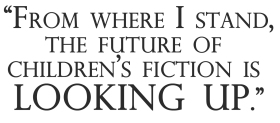 From where I stand, the future of children’s fiction is looking up. They will see more and more books where the covers feature people like them, of all races and creeds, beliefs and lifestyles. Everyone will have a chance to be a hero and every reader will find a place for themselves in the thrilling worlds of mystery, fantasy and science fiction. I can’t hide the huge smile on my face because the child in me is thrilled. I am so proud to be a part of this movement. I hope more writers of color will be encouraged to write from their cultural backgrounds and enrich the book world with new ideas. It wouldn’t surprise me that although the names and settings have been changed, in the end, we’ll discover that there is much that we share with each other; that we have more in common than we realize.
From where I stand, the future of children’s fiction is looking up. They will see more and more books where the covers feature people like them, of all races and creeds, beliefs and lifestyles. Everyone will have a chance to be a hero and every reader will find a place for themselves in the thrilling worlds of mystery, fantasy and science fiction. I can’t hide the huge smile on my face because the child in me is thrilled. I am so proud to be a part of this movement. I hope more writers of color will be encouraged to write from their cultural backgrounds and enrich the book world with new ideas. It wouldn’t surprise me that although the names and settings have been changed, in the end, we’ll discover that there is much that we share with each other; that we have more in common than we realize.
Valynne E. Maetani
Somewhere out there are children just like me. They use reading as a way to escape life’s obstacles. They enjoy being sucked into magical worlds that challenge their imaginations. Sometimes books help them realize their problems are not as bad as they seem. They realize through characters that difficulties are a part of the human experience, but there are others like them who feel and react the same way they do.
In other ways, those same children might be not like me. They are children who might know little about Japan and its foods or customs. They may not have any idea what’s it’s like to grow up Japanese-American or understand how deep-rooted our traditions are.
For all children, books are a way of making connections and allowing them to experience something new. Diversity in middle grade and young adult literature enriches the reading experience by increasing the breadth and depth of what our children have access to, and because of this, there is also an increased chance for children to connect and learn. Both characters and authors of color can provide an introduction to unique perspectives. I find that most intolerance stems from a lack of understanding, and books are one forum which can equip children with information. I’m not naïve enough to think diversity in genre fiction will change everything, but every time we connect with a child, we open doors, and that makes writing worth it.
Rahul Kanakia
In any discussion of diversity, the shadow constituency is white people. Obviously, it’s really nice for teens of color to see depictions of themselves in the media that they consume. But unless those depictions also appeal in some way to white people, then those depictions will not get the major play 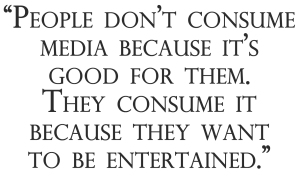 that they need in order to be published and widely distributed in a way that makes sure they get into the hands of people of color.
that they need in order to be published and widely distributed in a way that makes sure they get into the hands of people of color.
And, of course, we all know that it’s good for white people to see the diversity of the world. But that also doesn’t matter. People don’t consume media because it’s good for them. They consume it because they want to be entertained.
So the challenge is to create depictions of PoC that are also entertaining to white people. It’s hard. And it’s often a bit unsatisfying. Writing for an outsider audience means including explanations and “authentic” detail that insiders don’t necessarily need, or want, to see. And if you veer too much in that direction, then you alienate people of your own culture. And that alienation can often be good business, actually, because those people are actually just a tiny fraction of your audience and in terms of getting fame and book sales it makes a lot more sense to feed the preferences of a white audience that hungers for PoC characters who hang around in this tiny sweet spot where they’re alien enough to be picturesque but also relatable enough that they don’t pose a serious challenge to majority culture.
Akwaeke Emezi
I’m curious about what effect it would have had on me as a child and young adult to have had access to more fiction with characters that looked like me, or that came from cultures that I could have related to with more ease. I’ll never know, but I believe that kids nowadays should definitely have access to all that material and I am grateful for all those who are working to make this happen.
Disclaimer- I’m not very immersed in the writer world so this conversation is somewhat new to me. However, it seems to me that diversity in genre fiction (or the lack thereof) is essentially a race issue- who is considered the default race and the limited range of cultures, descriptions, etc that spring forth from that. It’s just not representative of the real world and it does people and children of color a disservice. Stories help people relate to whatever they’re reading about- I had no problem as a child believing that pixies lived in my compound or imagining that the tree in our backyard was The Faraway Tree even though all Enid Blyton characters were white. All children (all people, actually) would benefit greatly from having access to diverse fiction and being exposed to different cultures and people.
Ibi Zoboi
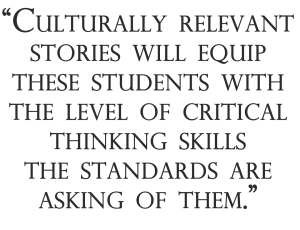 I teach in New York City public schools as a writer-in-residence. So I have a pretty good idea of what inner city children and teens are dealing with in terms of literacy. These new Common Core Learning Standards are asking students to read broadly and deeply—more informational nonfiction texts. And part of my job entails listening to teachers complain how this is a huge leap for many of their students. They’re being asked to argue these complex ideas and think critically, yet they have very little sense of themselves, their world and their place in it.
I teach in New York City public schools as a writer-in-residence. So I have a pretty good idea of what inner city children and teens are dealing with in terms of literacy. These new Common Core Learning Standards are asking students to read broadly and deeply—more informational nonfiction texts. And part of my job entails listening to teachers complain how this is a huge leap for many of their students. They’re being asked to argue these complex ideas and think critically, yet they have very little sense of themselves, their world and their place in it.
When I teach fiction in places like Brooklyn and the Bronx, I’d get so many blue-eyed, blonde-haired characters in these stories you’d think we were in Norman Rockwell’s America. They’re emulating what they have to read. Reading the classics is a good thing. But culturally relevant stories will equip these students with the level of critical thinking skills the standards are asking of them. A great number of sci-fi classics can be paired with well-written YA dystopian novels, for example. And what if they can see themselves and their culture in these books? Orwell’s 1984 then becomes that much more relevant.
Underrepresented students who experience school closures, substandard housing, and violence need to be able to think critically about a genre MG or YA novel and how it relates to them. They need to see themselves taking center stage in heroic stories before they can begin to affect change in their own communities.
Further Reading:
Meet Our New Visions Finalists I: How we got involved in the New Visions Award
Meet Our New Visions Finalists II: How we got involved in the New Visions Award
Meet Our New Visions Finalists III: Writing for people of different backgrounds
Meet Our New Vision Finalists IV: Your relationship to books as a young reader
Filed under:
guest blogger,
Musings & Ponderings,
Tu Books Tagged:
diversity,
New Visions Award,
Power of Words,
promoting diversity,
Race issues,
Science Fiction/Fantasy,
Teens/YA,
Tu Books,
writing contests 


By:
Amanda,
on 3/5/2013
Blog:
The Open Book
(
Login to Add to MyJacketFlap)
JacketFlap tags:
Awards,
writing contests,
diversity,
guest blogger,
Science Fiction/Fantasy,
Power of Words,
Musings & Ponderings,
Race issues,
Tu Books,
Teens/YA,
promoting diversity,
New Visions Award,
Add a tag
 In January we announced the finalists of our first New Visions Award, a new writing award for a debut author of color for a middle grade or young adult science fiction, fantasy, or mystery novel. Over the next few weeks, we’ll be highlighting these talented finalists on our blog as they answer questions about what inspires them, the writing process, and more. Perhaps among these five finalists you’ll find your next favorite author!
In January we announced the finalists of our first New Visions Award, a new writing award for a debut author of color for a middle grade or young adult science fiction, fantasy, or mystery novel. Over the next few weeks, we’ll be highlighting these talented finalists on our blog as they answer questions about what inspires them, the writing process, and more. Perhaps among these five finalists you’ll find your next favorite author!
Previous posts by our New Visions finalists:
Q: What was your relationship to books and reading as a child or teenager? In what ways did you see yourself represented in books?
Ailynn Knox-Collins
I was seven when I attended my first boarding school. Determined to hate the experience, I succeeded at being miserable. Over the next few years, I changed school six times. I was always the new kid, but I wasn’t the nice one. I got into fights, defied teachers and even started a gang to beat up boys (I didn’t actually beat up anyone). Adults whispered about me when they thought I wasn’t listening. I was the poor child whose parents were getting a divorce. Because of that, I got away with everything which just made me more miserable.
Then one day, a teacher introduced me to CS Lewis and his worlds brought a spark into my self-imposed misery. Books became my escape. I devoured every story, mostly fantasy at first. I began to write as well, putting myself in places where I could be somewhere or someone else. Meeting Austen, Hardy and the Bronte sisters began my love affair with classical English literature. Those were wonderful years. Finally, Asimov came along and that opened the world of science fiction to me. Life became hopeful even while aliens were invading and snatching bodies, because the heroes always triumphed. And that’s where I kept seeing myself, whether or not the characters looked like me or spoke like me. They came out on top at the end and in my darkest moments, that was what I needed the most.
Ibi Zoboi
I was one of those statistical kids who did not own books. My mother worked two jobs to send me to Catholic school and we lived in a part of Brooklyn where little girls did not skip to the library on their own. We did own encyclopedias, though, but not novels and picture books. This had more to do with culture rather than economics. For students in Haiti, reading was more for rote memorization of textbooks. That’s what my mother made me do with the encyclopedias.
I was dealing with some  serious identity issues by the time I got to high school. We’d moved to suburban Queens and I went to a mostly white Catholic high school. I desperately wanted mirror stories but I’d settled on having some sort of movie star idol instead. Halle Berry was just starting out then and she had starred in the TV movie Alex Haley’s Queen. That’s what led me to reading the actual book. Then I read Alex Haley’s Roots and looked for other titles in that section of my high school’s library—slave narratives (which at some point led me to Octavia Butler’s Kindred). Then I got mad at the world and worked in a bookstore all throughout college and read everything I could afford on my employee discount (RIP Waldenbooks).
serious identity issues by the time I got to high school. We’d moved to suburban Queens and I went to a mostly white Catholic high school. I desperately wanted mirror stories but I’d settled on having some sort of movie star idol instead. Halle Berry was just starting out then and she had starred in the TV movie Alex Haley’s Queen. That’s what led me to reading the actual book. Then I read Alex Haley’s Roots and looked for other titles in that section of my high school’s library—slave narratives (which at some point led me to Octavia Butler’s Kindred). Then I got mad at the world and worked in a bookstore all throughout college and read everything I could afford on my employee discount (RIP Waldenbooks).
It all started with wanting to see an image of beauty and success that was real to me. Halle’s hair was short and she was black and she’d been a heroine. I don’t think I would’ve been so superficial if I’d seen some of those images in books as a child.
Rahul Kanakia
My mom gave me Isaac Asimov’s Foundation when I was around 10 years old. She’d first read it as a kid in Mumbai in the 1960s. I loved the book’s thought-provoking premise and epic scope and I knew that I wanted more of that. Until I went to college, I only read science fiction and fantasy novels: mostly hard science fiction, space operas, military SF, epic fantasy, and swords and sorcery.
All of these subgenres are largely comprised of adventure stories. They’re about heroes who triumph over tremendous obstacles. And, because I read hundreds and hundreds of these books, I wanted to grow up and become a hero. Many SF fans of color go through a period of disillusionment when they realize that the genre doesn’t care to represent them. That did not happen to me. For whatever reason, I had no trouble identifying with the square-jawed white protagonists.
My disillusionment arose when I realized that heroism is a bit of a sham. It doesn’t exist in real life. Or, at least, not in the way that they write about it in the stories. Of course, everyone realizes that eventually. And, after growing up, some people are still able to find value in the metaphor: the hero represents some spiritual transcendence or state of striving. But I was never able to get over my disappointment. To this day, I find it difficult to read a traditionally-structured SF novel.
Valynne E. Maetani
In the third grade, I skipped recess so that I could read a series of non-fiction books. Each detailed the life of someone famous in history. Only one of those books was about a woman: Marie Curie.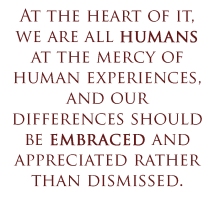 Shewas smart and brave, and I wondered if I could ever be like her. Often, my father would surprise me with books. Each had strong female characters like those in Little Women or The Good Earth. In our Asian culture, where emotions are rarely exposed, this was his way of telling me that he believed I could be brave and strong like Madame Curie, the March women, or O-Lan.
Shewas smart and brave, and I wondered if I could ever be like her. Often, my father would surprise me with books. Each had strong female characters like those in Little Women or The Good Earth. In our Asian culture, where emotions are rarely exposed, this was his way of telling me that he believed I could be brave and strong like Madame Curie, the March women, or O-Lan.
At some point, I fell in love with mysteries, devouring Encyclopedia Brown and eventually books by Agatha Christie. Yet I realized there were rarely characters of color. So a few years ago I decided to write a book for my youngest sister’s eighteenth birthday. I had a vague idea of the storyline but knew it would be a mystery; the protagonist would be a strong young woman; and she and her family would be Japanese. What I wanted to share through my writing is that as much as we try to fit in with those around us, we will always be different. I realized, once I was older, that being different is the precise thing my friends loved about me and my family. At the heart of it, we are all humans at the mercy of human experiences, and our differences should be embraced and appreciated rather than dismissed.
Akwaeke Emezi
My relationship to reading has always been a huge part of my life and luckily, both my parents were avid readers who happily loaded me up with books. I read everything I could find; my favorites were authors like Lewis Carroll, Kipling, James Herriot, Enid Blyton, C.S. Lewis, J.K. Rowling, etc. I also rea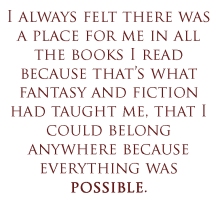 d several classics as a child/teen simply because they were in my house and I needed things to read: Anna Karenina, Crime and Punishment, The Odyssey, A Tale of Two Cities, etc. I remember reading Flowers in the Attic before I was ten…that was quite an experience!
d several classics as a child/teen simply because they were in my house and I needed things to read: Anna Karenina, Crime and Punishment, The Odyssey, A Tale of Two Cities, etc. I remember reading Flowers in the Attic before I was ten…that was quite an experience!
I was always reading at the dinner table, at school while on break, by candlelight because the power was always out, in the bathroom- I was insatiable and churned through books quickly. We had an outdoor book market at the Post Office in my town in Nigeria, where you could bring second hand books and swap them out for more, which was a great resource.
As a child/teen, I always felt there was a place for me in all the books I read because that’s what fantasy and fiction had taught me, that I could belong anywhere because everything was possible.
Further Reading:
Meet Our New Visions Finalists I
Meet Our New Visions Finalists II
Meet Our New Visions Finalists III
Filed under:
Awards,
guest blogger,
Musings & Ponderings,
Tu Books Tagged:
diversity,
New Visions Award,
Power of Words,
promoting diversity,
Race issues,
Science Fiction/Fantasy,
Teens/YA,
writing contests 


By:
keilinh,
on 2/26/2013
Blog:
The Open Book
(
Login to Add to MyJacketFlap)
JacketFlap tags:
Science Fiction/Fantasy,
Power of Words,
Musings & Ponderings,
Race issues,
cultural diversity,
Tu Books,
Teens/YA,
New Visions Award,
different cultures,
Awards,
writing contests,
diversity,
writing,
Add a tag
 Last month we announced the finalists of our first New Visions Award, a new writing award for a debut author of color for a middle grade or young adult science fiction, fantasy, or mystery novel. Over the next few weeks, we’ll be highlighting these talented finalists on our blog as they answer questions about what inspires them, the writing process, and more. Perhaps among these five finalists you’ll find your next favorite author!
Last month we announced the finalists of our first New Visions Award, a new writing award for a debut author of color for a middle grade or young adult science fiction, fantasy, or mystery novel. Over the next few weeks, we’ll be highlighting these talented finalists on our blog as they answer questions about what inspires them, the writing process, and more. Perhaps among these five finalists you’ll find your next favorite author!
Q: What has been your experience writing from a different cultural background that may be unfamiliar to most young readers?
Ibi Zoboi, Haiti.
While most readers are familiar with Edwidge Danticat, there are, of course, other Haitian and non-Haitian writers telling stories about Haitian children. M. Sindy Felin’s Touching Snow was a National Book Award Finalist. The recent winner of the Printz Award is In Darkness, a story about a Haitian boy during the earthquake written by Nick Lake. One of my favorite Haitian YA books is Taste of Salt by the late Frances Temple.
Haiti has an amazing literary tradition and under a brutal dictatorship, writers either risked their lives or were sent into exile. So, for me, writing about Haiti is very political. Though, my stories are cloaked in a world of magic. What better way to convey Haiti’s complex history and mythology than in a young adult fantasy novel? This simply adds another layer of depth to what young readers already know about Haiti, or any given culture. They must know that culture is multi-dimensional and is not regulated to the superficial “facts” in the media. This is why mythology breathes life into everything I write. While the names and magical systems differ, there is an interconnecting power in world mythology that can resonate with any reader.
Ailynn Knox-Collins, Earth.
I’ve lived in six countries and been a citizen of three, so it’s hard to decide where my origins lie. I immersed myself into the language and culture of each of the lands that have housed me and made me feel welcome. Yet, I belong to none in particular. Many people live in a culture different from their ancestors or like me, have ancestors from all over. We learn to hang on to the crucial values and adapt to others within our environment.
As a child, for example, I learned to ‘chameleon’ my accent simply to fit in. I write to discover who I am and I believe I’m not alone in this journey. In my books, I place my characters in almost sterile environments just to see what happens, so what is truly important can bubble to the surface. It seems appropriate in my form of science fiction, where the story is set in space, and humanity must rebuild itself by deciding what to keep and what to leave behind. I pepper the stories with values and beliefs I’ve picked up on the way, hoping that many of these are universal, since in the end, we are all but citizens of this one tiny planet.
Valynne E. Maetani, Japan.
Though I am fourth-generation pure Japanese, there were many traditions that my family maintained. As a child, I removed my shoes before I entered the house, ate certain kinds of foods on holidays, and threw salt over my shoulder on New Year’s Day. But I had no idea why we did the things we did. For me, writing about the Japanese culture has been a way of sharing and understanding the meaning and purpose behind the traditions.
I like writing for young adults because it’s an age where kids no longer do things just because their parents tell them to. It’s an age where they begin to question why on a much deeper level. In order for traditions to be preserved, I think it’s important to first understand the why and the rich history behind those traditions and second, important to share that knowledge with others.
Rahul Kanakia, India.
There is a lot of literature about the Indian diasporic experience. And, when I was around fourteen years old, I went through a phase where I read a fair amount of it.
And I hated it.
The standard Indian immigrant narrative is about the angst and the pain of being trapped between worlds. It is about attempting to assimilate and finding that assimilation was impossible. It is about attempting to recover an Indian cultural identity and finding that to be impossible as well. It is, fundamentally, about always feeling alone in the world. Kind of a grim future to outline for a fourteen year old who just wants to, you know, experience the world and make friends and write books and be happy.
So I try to write stories where Indian protagonists aren’t oppressed by their heritage. I think part of the reason I like writing science fiction is that in an SF novel, there’s always something else going on. You might be struggling to fit in…but you’re also struggling to fight off the zombie hordes.
Akwaeke Emezi, Nigeria + Malaysia.
My cultural background is blended- I was born in Nigeria and lived there until I left for college, so I identify very strongly with being Igbo. I was also raised with my mother’s Malaysian culture, so although I can’t cook Nigerian food to save my life, I tie my own saris, wear jade, and ritually stockpile Baba’s Curry Powder. However, moving to the States brought my nationality to the foreground as an immigrant, and that was when I realized how much growing up in Nigeria impacted my identity.
I deliberately reached for what felt like home and birthright while I was writing Somadina. I was born where my father was born and his father before him, so I constructed a fantasy world around Igbo culture and traditional religion. Other than Nnedi Okorafor’s delightful work, I hadn’t seen my culture represented in speculative fiction, so I saturated this story in it.
I also write from different points of myself outside of my ethnicities, but elements of my cultures often seep through in a name/food/phrase. After all, where I come from shapes who I am now, with half a body in the otherworld, stories coming through my teeth, and all.
Further Reading:
What brought our New Visions finalists to Tu Books and to the New Visions Award competition in particular?
Ailynn and Valynne answer
Ibi, Rahul, and Akwaeke answer
Filed under:
Awards,
Musings & Ponderings,
Tu Books Tagged:
cultural diversity,
different cultures,
diversity,
New Visions Award,
Power of Words,
Race issues,
Science Fiction/Fantasy,
Teens/YA,
Tu Books,
writing,
writing contests 


By:
Amanda,
on 2/20/2013
Blog:
The Open Book
(
Login to Add to MyJacketFlap)
JacketFlap tags:
Science Fiction/Fantasy,
Power of Words,
Musings & Ponderings,
Race issues,
Tu Books,
Teens/YA,
New Visions Award,
Awards,
writing contests,
diversity,
Add a tag
 Last month we announced the finalists of our first New Visions Award, a new writing award for a debut author of color for a middle grade or young adult science fiction, fantasy, or mystery novel. Over the next few weeks, we’ll be highlighting these talented finalists on our blog as they answer questions about what inspires them, the writing process, and more. Perhaps among these five finalists you’ll find your next favorite author!
Last month we announced the finalists of our first New Visions Award, a new writing award for a debut author of color for a middle grade or young adult science fiction, fantasy, or mystery novel. Over the next few weeks, we’ll be highlighting these talented finalists on our blog as they answer questions about what inspires them, the writing process, and more. Perhaps among these five finalists you’ll find your next favorite author!
Q: What brought you to Tu Books and to the New Visions Award competition in particular?
Rahul Kanakia, Baltimore, MD:
My novel has a number of autobiographical elements. I mean, obviously, I didn’t grow up in a plague-wracked authoritarian dystopia, but I did share many of the troubles and experiences of the character in my novel. I went to Catholic school and I was confused regarding my sexual orientation and I had body image issues. And when I started the first draft of my very first YA novel, all of that came out of me in a crazy rush. Nothing was filtered. Everything was on the paper. Never before nor since have I experienced that kind of pure mind to keyboard translation.
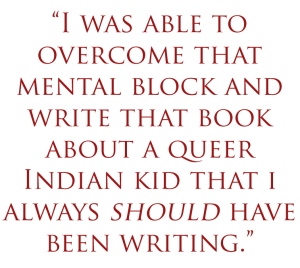 Except for one thing. The protagonist of that first draft was white. That’s because (kind of funnily, since I’m currently enrolled in an MFA program that’s more-or-less devoted to the creation of fine literature), I’m relentlessly commercial. I can’t ever get up the motivation to write something that I don’t think will sell. And, you know, I believed it was possible to sell a YA novel with a queer protagonist. And I believe it’s possible to sell a YA novel with a protagonist of color. There are (a few) examples of both of those things. But I just was not at all sure that it was possible to sell a YA novel with a protagonist who was both. Somehow, the intersection felt too narrow. I don’t know. Perhaps I was the unimaginative one there. Perhaps I didn’t give the publishing industry enough credit. But before I could even start to write that book, I felt like I had to choose one identity and discard another.
Except for one thing. The protagonist of that first draft was white. That’s because (kind of funnily, since I’m currently enrolled in an MFA program that’s more-or-less devoted to the creation of fine literature), I’m relentlessly commercial. I can’t ever get up the motivation to write something that I don’t think will sell. And, you know, I believed it was possible to sell a YA novel with a queer protagonist. And I believe it’s possible to sell a YA novel with a protagonist of color. There are (a few) examples of both of those things. But I just was not at all sure that it was possible to sell a YA novel with a protagonist who was both. Somehow, the intersection felt too narrow. I don’t know. Perhaps I was the unimaginative one there. Perhaps I didn’t give the publishing industry enough credit. But before I could even start to write that book, I felt like I had to choose one identity and discard another.
Fast forward a year. I’d had a story appear in Tu Books’ Diverse Energies anthology of YA dystopian fiction. And, because of that, I got forwarded an email where Tu called for submissions to their first contest: they actually wanted novels about people of color. I had this YA novel, which still hadn’t really been marketed to publishers, and, after thinking about it for awhile, I decided to go back in and rewrite it to fit the vision that I hadn’t originally been courageous enough to realize. Because of this contest, my novel exists in a form that it wouldn’t have otherwise had: I was able to overcome that mental block and write that book about a queer Indian kid that I always should have been writing.
I think that’s the benefit of having a publisher for books about and by people of color. It doesn’t only publish diverse and inclusive books…it also widens the entire marketplace. Just knowing that there is a potential home for books that explore all kinds of PoC experiences will do a lot to foster the writing of more and broader types of books.
Rahul Kanakia is a science fiction writer who has sold stories to Clarkesworld, the Intergalactic Medicine Show, Apex, Nature, and Lady Churchill’s Rosebud Wristlet. He currently lives in Baltimore, where he is enrolled in the Master of the Fine Arts program in creative writing at Johns Hopkins University. If you want to know more about him then please visit his blog at http://www.blotter-paper.com or follow him on Twitter at @rahkan
Ibi Zoboi, Brooklyn, NY
I’ve known about Tu Books since its Kickstarter campaign. I did get a little teary-eyed watching that video because a whole world had opened up for me. Not just for me as a writer, but for me as a reader, educator, and parent. I was probably one of Tu Books’ first contributors, having prematurely sent an unpolished manuscript. I’ve been at this writing thing for quite some time—submitting, revising, re-submitting—all while reading the online conversations around diversity in children’s books. There were some good discussions but they were just that—discussions. I was doing my part as a writer by working on my craft and submitting work. What were agents and editors on the other side of the gate doing to actually shift the dynamics and raise the number of books published for children of color?
Lee & Low Books was one answer. Tu Books was even better by filling the humungous need for genre MG & YA books featuring characters of color. This was actually doing something! The New Visions Award was a huge clarion call for us writers of color to step forward and shout like the Whos in Whoville, “We are here!”
I would’ve been first in line sending my manuscript off by Owl Post Express the day the contest was announced, but I’d just gotten into an MFA program and was at the mercy of my adviser. I planned to work on my manuscript the whole semester and if she said that it needed work, I wasn’t applying. I’d made a commitment to really learn the craft and wouldn’t dare send out work that wasn’t ready (I’d done that too often). But she told me, “Get your application in yesterday!” And “yesterday” ended up being almost at the last minute on the heels of Hurricane Sandy.
I’d agonized over whether a story about a Haitian girl was good enough, whether I should send one about a regular black American girl instead and not dig so deep into culture and mythology. It’s one thing to write fantasy as a person of color, it’s another thing to write as an immigrant and pull from your own culture to tell a story that can resonate with anyone.
There are lots of us writing, and it would be such a disservice to children who are desperately in need of mirrors and windows to not provide resources for writers of color to hone their craft. Prizes, awards, grant money, scholarships—just about anything that would close the gap in some way. Yep, the New Visions Award is one step towards that, and SCBWI did something similar with their On-the-Verge Emerging Voices Award. Hopefully, with time, more avenues will open up.
And yes, congratulations fellow Whos! I’m honored to be a finalist and in such great company.
Ibi Zoboi’s short stories have been anthologized in The Caribbean Writer, Dark Matter 2, and Haiti Noir edited by Edwidge Danticat, among others. She’s received grants in Writing from the Brooklyn Arts Council and is studying Writing for Children & Young Adults at Vermont College of Fine Arts. She’s a mom of three, married to a visual artist, and teaches writing in New York City public schools. You can find her at www.ibizoboi.com.
Akwaeke Zara Emezi, Brooklyn, NY
I came across Tu Books by chance, while going through the contest listings on the Poets & Writers website. The New Visions Award struck me because of how specific its guidelines were, and as a writer of color, I leapt at the opportunity to be part of something geared specifically towards children of color. I’m the Igbo and Tamil child of a Nigerian man and a Malaysian woman, and I grew up in Nigeria, straddling cultures like most mixed kids do, marked as ‘half-caste’ and essentially a foreigner in my home community. Finding places where I belong has always been important to me. 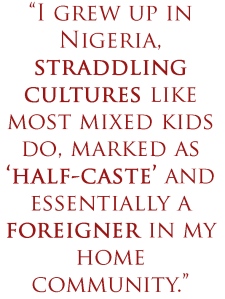
Both my parents loved reading and made sure I had a constant supply of books as a child growing up in Aba. Most of these books were written by authors such as Enid Blyton and C.S. Lewis, and they all featured white children as the characters. Therefore, when I started writing books as a child (here’s one of them), all the people I created in my make believe worlds were also white and with Western names, even though I was born and raised in a deeply Igbo region of Nigeria. The books I’d read were the usual portal into other realities, which I ruthlessly applied to my childhood, convinced that pixies lived in the patch of grass in front of our house and that fairies filled my bedroom, entertained by my sister and I playing. It was easier to fit into these imaginary places.
My love for speculative fiction developed from this, and the chance to develop a fantasy world for the New Visions Award was a perfect match for me. I actually wrote Somadina specifically for this award after I found out about it, penning down a few chapters to meet the submission deadline and drawing heavily from Igbo culture and history to craft a world that I would have liked a portal to myself. I wrote with young adults in mind and worried that perhaps some elements of the story would be a little too dark, but I kept reminding myself that the reality for many young adults of color is that they are likely to personally witness or experience the ‘dark’ themes that are present in my narrative. I had to stay true to the story and tell it the way it was insisting on being told.
All in all, I’m deeply honoured to be a finalist with all these other amazing writers, and extremely grateful to Tu Books for its existence and for this opportunity.
Akwaeke Zara Emezi is an Igbo and Tamil writer who was born and raised in the south of Nigeria. She started writing at five and in the succinct words of her seven year old self- “Her ambition is to be a world famous writer and artist. She has a family of 5 and loves art and books. Her hobby is writing.” Akwaeke now lives in Brooklyn and can be found online at www.azemezi.com.
Meet Our Other Two New Vision Finalists
Filed under:
Awards,
Musings & Ponderings,
Tu Books Tagged:
diversity,
New Visions Award,
Power of Words,
Race issues,
Science Fiction/Fantasy,
Teens/YA,
Tu Books,
writing contests 


By:
Hannah,
on 2/19/2013
Blog:
The Open Book
(
Login to Add to MyJacketFlap)
JacketFlap tags:
Awards,
writing contests,
diversity,
Science Fiction/Fantasy,
Power of Words,
Musings & Ponderings,
Race issues,
Tu Books,
Teens/YA,
New Visions Award,
Add a tag
 Last month we announced the finalists of our first New Visions Award, a new writing award for a debut author of color for a middle grade or young adult science fiction, fantasy, or mystery novel. Over the next few weeks, we’ll be highlighting these talented finalists on our blog as they answer questions about what inspires them, the writing process, and more. Perhaps among these five finalists you’ll find your next favorite author!
Last month we announced the finalists of our first New Visions Award, a new writing award for a debut author of color for a middle grade or young adult science fiction, fantasy, or mystery novel. Over the next few weeks, we’ll be highlighting these talented finalists on our blog as they answer questions about what inspires them, the writing process, and more. Perhaps among these five finalists you’ll find your next favorite author!
Q: What brought you to Tu Books and to the New Visions Award competition in particular?
Ailynn Knox-Collins. Redmond, WA:
I came across Tu Books when I bid on a copy of Tankborn for a charitable cause. Soon after, I had the good fortune to sit next to the writer, Karen Sandler, at an SCBWI conference in LA. I was delighted to find an imprint that is dedicated to putting books out there that are written by and feature characters of color.
Why is it important, you say, that there be this need to highlight multi-ethnic writers and stories? Because to me the world is colorful and always has been, but many of the books I love haven’t always reflected it. Too much of my own childhood was spent thinking that to be a hero or heroine, I had to look a certain way, and mostly not like me. Yet, when I look at the amazing people in the world I grew up in, they came from all sorts of backgrounds, colors and cultures.
So I had to be a part of this endeavor and I congratulate Tu Books on their first ever New Visions Award. I submitted my science fiction story and (wow!) now I’m a finalist. The other finalists are remarkable writers from excitingly varied backgrounds. I am honored to be in this group with them.
I’m a person of mixed ethnicity. My Chinese mother married an Englishman at a time when that act alone could get you disowned by your 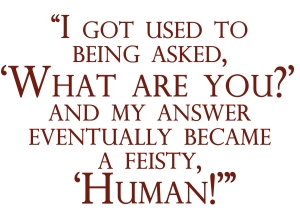 family. I grew up in several countries from England to Singapore. As a child I had my hair stroked by strangers (“Interesting color.”), my nose pinched (“Your ‘bridge’ is so high” or “flat” depending on the country) and my eyes commented on (“Ooh! Double lids.”). I got used to being asked, “What are you?” and my answer eventually became a feisty, “Human!”
family. I grew up in several countries from England to Singapore. As a child I had my hair stroked by strangers (“Interesting color.”), my nose pinched (“Your ‘bridge’ is so high” or “flat” depending on the country) and my eyes commented on (“Ooh! Double lids.”). I got used to being asked, “What are you?” and my answer eventually became a feisty, “Human!”
When I began writing seriously a decade ago, my fictional worlds reflected how I see the real world. My characters naturally look like people I’ve encountered in my life, and they are of all colors. In GENERATION ZERO, my entry to the New Visions Award, everyone happens to be of mixed ethnicity for a horrid, sinister reason — “Mixed breeds are sturdier, like mongrel dogs”. Strangely, someone actually said that to me long ago. Astonishing, isn’t it?
I am so excited to play a small part in bringing attention to something that has been close to my heart for so long. I fell in love with books the day a teacher sat our class under the shade of a giant Raintree and read to us from CS Lewis’ The Lion, The Witch and The Wardrobe. I longed to be one of the Pevensies, but I couldn’t ignore the fact that they, and many subsequent heroines I loved, looked nothing like me. I did my best to ignore descriptions, but I couldn’t help feeling left out. If, as a writer, I can make one child imagine herself the heroine of a story, and know that nothing, especially not the color of her skin, can stop her from achieving her dreams, then I will be satisfied and incredibly humbled.
Well done, Tu Books for your vision and congratulations to all the finalists of the New Visions Award.
Ailynn Knox-Collins is a mother and teacher, as well as a ‘crazy dog lady’ with four great rescues who slobber all over the furniture (well, what else is it for anyway). She is an unashamed Trekkie and is learning to speak Klingon to add to the other 6 languages she already speaks. She loves to read everything and has been inspired to write science fiction so that young people today can experience the same wonder she did growing up. Please visit her at www.taknoxcollins.wordpress.com and follow her on Twitter @talkc
Valynne E. Maetani, Salt Lake City, UT
Initially, I heard about Tu Books when it was still Tu Publishing, and I was ecstatic about its mission . . . and a little dismayed that I didn’t think my book qualified for submission. At the time, I thought they were only interested in fantasy and sci-fi. While my book had a fantasy fairy-tale element, it would definitely be classified as a mystery.
Imagine how excited I was when I heard about the New Visions Award given to a fantasy, sci-fi, or mystery novel. Unfortunately, it was three weeks before the submission deadline. With so little time and a manuscript in dire need of revisions, I realized I couldn’t make it. 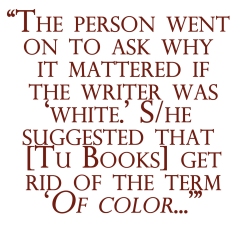
Determined to support their mission, I told myself I would send a manuscript in through their regular submission process at some later date.
But then someone replied to the announcement for the award with the following response: “I was slightly concerned to see that this publisher was seeking submissions for a contest, but only from writers ‘of color’ . . . It appears that the means to the laudable end of ‘true diversity’ in YA/MG lit is more submissions by ‘authors of color.’” The person went on to ask why it mattered if the writer was “white.” S/he suggested they get rid of the term “of color” from all the fine print of their website.
I am the first to say that I have read many wonderful books, with diverse characters, written by authors who are not “of color”—books that were meaningful and shed light on different cultures such as The Good Earth by Pearl Buck or Under the Blood Red Sun by Graham Salisbury. But to me, underrepresented voices are just as important. This award matters. I am a Japanese-American writer, who grew up in Utah, surrounded by people who looked nothing like me, reading books about people who looked nothing like me. I am an author of color. Our voices matter.
And so I worked hard to get my chapters ready for submission.
I truly appreciate that Tu Books seeks to encourage diversity in children’s literature as well as diversity in the authors who write these books. I am humbled and awed by the talent of the other New Visions Award finalists, and I am proud to have my name listed with theirs.
Valynne E. Maetani received a BA from the University of Pennsylvania. She has managed script editing for stories for disadvantaged youth and has edited several screenplays, including My Little War in Juarez, the winner of the 2010 Creative World Award. She can be found at www.valynne.com and on Twitter @valynnemaetani
Stay tuned tomorrow for part II as we hear from our other three finalists!
Filed under:
Awards,
Musings & Ponderings,
Tu Books Tagged:
diversity,
New Visions Award,
Power of Words,
Race issues,
Science Fiction/Fantasy,
Teens/YA,
Tu Books,
writing contests 


By:
Amanda,
on 2/4/2013
Blog:
The Open Book
(
Login to Add to MyJacketFlap)
JacketFlap tags:
diversity,
Book Lists,
Resources,
guest blogger,
Educators,
Power of Words,
Race issues,
common core standards,
Curriculum Corner,
windows and mirrors,
Add a tag
 Guest blogger Katie Cunningham is an Assistant Professor at Manhattanville College. Her teaching and scholarship centers around children’s literature, critical literacy, and supporting teachers to make their classrooms joyful and purposeful. Katie has presented at numerous national conferences and is the editor of The Language and Literacy Spectrum, New York Reading Association’s literacy journal.
Guest blogger Katie Cunningham is an Assistant Professor at Manhattanville College. Her teaching and scholarship centers around children’s literature, critical literacy, and supporting teachers to make their classrooms joyful and purposeful. Katie has presented at numerous national conferences and is the editor of The Language and Literacy Spectrum, New York Reading Association’s literacy journal.
When we lived in Brooklyn, I knew my sons were growing up in a diverse community. They understood that people have different skin colors. That people speak different languages. That people eat different foods. That people believe different things. That we all share a common humanity. That life is full of complexity.
Now we live in the woods and appreciate the quiet of country living but this is far from a diverse community. For my boys, there is greater diversity in the pages of a book than on the streets of their town. Multicultural children’s literature is a doorway into greater understanding that their cultural background is not the only cultural background. That their way of speaking is not the only way of speaking. That their point of view is not shared by everyone.
When we open a book and start to read a story, we use our imaginations to walk through whatever world the author has created. Children’s literature is full of stories about boys and girls that look like my children. Rudine Sims Bishop uses the terms mirror books and window books to describe how we both see ourselves and see others when we read literature. The characters my sons encounter are often mirrors and they find their life experiences reflected in the books they read. Children from dominant social groups have always found their mirrors in books, but do they have enough access to high-quality stories that represent other cultural backgrounds in a positive way?
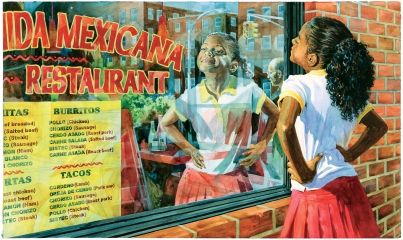
artwork by Chris Soentpiet from Amazing Faces
My sons need more than mirror books. As I scan our reading shelves at home I know we can do better. When I walk into many classrooms, I know they too can do better. My sons and all children need books that provide windows into other life experiences to understand the diverse world we live in and to build connections to all other humans. After all, when the lighting is just right can’t a window become a mirror?
My friend, colleague, and global literacy leader Pam Allyn takes Charlotte’s Web with her when she travels to Lit Clubs in Kenya, Haiti, and South Korea. She takes Charlotte’s Web because even though the children she meets do not look like or speak like Fern, there is a shared humanity in E. B. White’s words that is unparalleled, and all children can find a mirror in Fern’s courageous spirit. Pam has created Lit Clubs and Lit Camps through her organization LitWorld that emphasize the human strengths found in stories. Imagine if all the stories we read with children were framed around human strengths? What strengths would you choose?
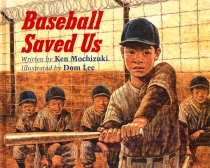
Of course, stories also help us understand that the world we live in is not what it should be. Stories can help young children understand that racism very much exists in this country, and that power is unequally distributed based on race, class, and gender. For children from dominant groups, window moments in stories come when the children realize they hold a powerful place in society and that there is something unjust about this. Two stories that center on human strength and offer powerful mirror/window possibilities for children are Baseball Saved Us by Ken Mochizuki and Seeds of Change: Planting a Path to Peace by Jen Cullerton Johnson. Baseball Saved Us is about an underdog believing in himself and the strength that comes from confidence, but it also tells about an ugly chapter in United States history when Japanese Americans were sent to internment camps during World War II. Seeds of Change is a story of perseverance in the face of political opposition and bias against women. It is also about respecting nature and the power of collective action to change a landscape and the sustainability of a nation. There are many more such stories. Yet, are we reading them to children at home and in our classrooms?
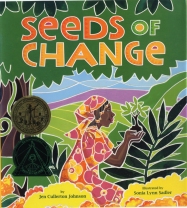
President Obama in his Second Inaugural Address emphasized the legacy of Dr. Martin Luther King Jr. when he said, “our individual freedom is inextricably bound to the freedom of every soul on Earth.” Stories can help children realize this. Isn’t a sense of social justice something we want all children to develop? Through the thoughtful selection of books we read to our children we take a step toward creating adults who desire a world that is better than the one we live in today.
So, parents and teachers, what can you do?
- Acknowledge that every story has mirror and window possibilities
- Emphasize that we live in a diverse society
- Arm students with stories where their background is represented in a positive light and where their life experiences are validated
- Discuss themes in stories to unpack mirror possibilities for all children
- Read aloud stories that represent positive aspects of the human spirit and where characters rally together for collective action
- Be open to discussions of inequality that you see in stories and in life; discuss with children a vision for a better world
- Look for links to literacy standards such as the Common Core State Standards Reading Literature Standard 6 across grade levels; this is a strand of standards that emphasizes point of view
Further reading:
What’s in your classroom library? Rethinking Common Core recommended texts
A More Diverse Appendix B
Filed under:
Book Lists,
Curriculum Corner,
guest blogger,
Resources Tagged:
common core standards,
diversity,
Educators,
Power of Words,
Race issues,
windows and mirrors 

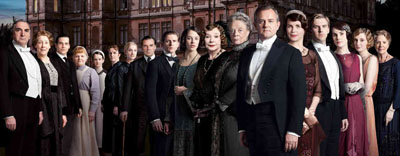
***Spoiler Alert *** My wife is a serious Downton Abbey fan, so as a result I have been following the show too. Downton packs a lot into forty-five minutes. I enjoy the period touches and the constant habit the English have of not being physically capable of communicating openly about well, everything. What is fascinating is how the show is placed in the context of history when change (World War I, economic concerns, women’s suffrage, the roaring twenties) is being forced on the Abbey whether the people there are ready for it or not. I have my favorites—Matthew Crawley and his Mum, and Maggie Smith’s comic timing as the Dowager. They always provide a good laugh. I also find Lord Grantham to be an interesting character. His impeccable posture and royal air hide an unsure man with a great many weaknesses just beneath the surface.
Toward the end of the first season I began to notice that something was missing. Where were the people of African, West Indian, and Indian descent? Aside from the brief appearance and demise of the Turkish diplomat Mr. Pamuk, I never saw any people of color. When the youngest daughter, Sybil, elopes with Tom, the chauffeur, I liked the chasm it created, how issues of class came to the forefront. Tom was definitely the outsider, and was treated with contempt by the royals and the servants alike. Tom’s romance and eventual marriage to Sybil upset the delicate balance between the Abbey’s masters and its staff.
For a television series that goes to great lengths to get all the nuances of the period right, historical accuracy should force the writers to inject some degree of race into the show. There are some rumblings from the show’s writers and other places online that there are plans to make the show more diverse. When they do, it should create opportunities for some cracking good storytelling.
Filed under:
Dear Readers Tagged:
diversity,
race in entertainment,
race in TV,
Race issues 


By:
keilinh,
on 2/1/2013
Blog:
The Open Book
(
Login to Add to MyJacketFlap)
JacketFlap tags:
Holidays,
History,
diversity,
Giveaways,
black history month,
Book giveaway,
Celebrations,
African/African American Interest,
Race issues,
Add a tag
It’s Black History Month, and that means it’s time for our annual giveaway from Lee & Low Books! We’re giving away three sets of three books featuring African Americans, and the contest will run through February 28, 2013.
To enter, follow in the footsteps of Dave the Potter, the subject of our new biography Etched in Clay: The Life of Dave, Enslaved Potter and Poet. Dave was an enslaved potter in South Carolina who inscribed his works with sayings and short poems in spite of harsh anti-literacy laws for slaves:
horses mules and hogs —
all our cows is in the bogs —
there they shall ever stay
till the buzzards take them away ==
March 29, 1836
I wonder where is all my relation
friendship to all — and, every nation
August 16, 1857
Write your own couplet in the comments below (it could be about anything, and doesn’t have to rhyme) to be entered in our giveaway. We’ll choose a winner at random.
Other ways to enter (or get up to 3 additional entries, if you also write a couplet):
1.) Follow us on Pinterest and let us know in the comments.
2.) Subscribe to this blog and let us know in the comments.
3.) Follow us on Twitter or like us on Facebook and let us know in the comments.
Check out some of the books you can win! Excited? We thought so!
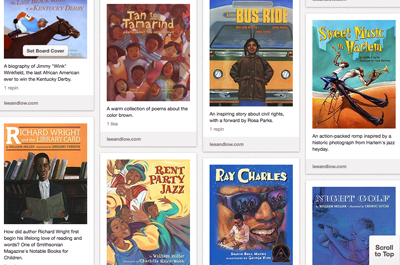
These are the book prizes.
We’ll be notifying the winners and sending out books after Black History Month is over, but we think our titles hold up year-round, not just during February! Black history is part of American History, and shouldn’t get relegated to one month out of the year. So enter below to win three great books to enjoy all year long!
[note: US addresses only]
Filed under:
Celebrations,
Giveaways,
Holidays Tagged:
African/African American Interest,
black history month,
Book giveaway,
diversity,
History,
Race issues 

In this post, our publicity intern Gina Chung offers some thoughts on reframing the Columbus Day holiday:
Have you ever stopped to think about the implications of celebrating Columbus Day? While most of us probably grew up associating the holiday with classroom rhymes and pneumatic devices (“In 1492, Columbus sailed the ocean blue,” etc.), days off from school, or sales at the mall, it’s important to remember what really happened in October of 1492. Columbus Day occupies a dubious spot in our nation’s calendar, ostensibly commemorating both the “discovery” of the Americas by Christopher Columbus and the subsequent destruction and enslavement of countless indigenous people.
Check out this video created by Nu Heightz Cinema filmmakers Carlos Germosen and Crystal Whelan in 2009. In order to garner support for a movement to “reconsider Columbus Day,” Germosen and Whelan collaborated with indigenous organizations and community activists, giving voice to the horrific and painful stories behind the mythology of the holiday.

In fact, there’s been a push to eliminate Columbus Day altogether and replace it with a federal holiday in honor of Native Americans. As this petition mentions, several states, such as Alaska, no longer recognize Columbus Day, or have replaced it with a day honoring indigenous people.
For example, since 1990, South Dakota has celebrated the second Monday of every October as Native American Day. In California, Berkeley replaced Columbus Day with Indigenous People’s Day in 1992, and in 1998, legislation calling for Native American Day to be celebrated as an official California state holiday on the fourth Friday of every September was also passed. Hawaii also celebrates Discoverers’ Day instead of Columbus Day in order to recognize the Polynesian discovery of the Hawaiian Islands. Many tribal governments have also reclaimed the day as Native American Day, or, like the Navajo Nation, have replaced it with a holiday honoring their own tribe.
Here are two books we found that, like the alternatives listed above, aim to dispel the myths around Columbus Day:
A Coyote Columbus Story, written by Thomas King, a Canadian novelist and broadcaster of Cherokee and Greek descent, and illustrated by Kent 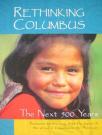 Monkman, a Canadian multimedia artist of Cree ancestry. It tells the story using the figure of Coyote, a traditional trickster character who, in King’s retelling, is a girl who loves to play ball!
Monkman, a Canadian multimedia artist of Cree ancestry. It tells the story using the figure of Coyote, a traditional trickster character who, in King’s retelling, is a girl who loves to play ball!
Rethinking Columbus: The Next 500 Years, edited by Bill Bigelow & Bob Peterson. This collection of essays, articles, poems, teaching ideas, and primary source materials helps educators teach students how to think critically and creatively about the consequences of the arrival of Europeans on the North American continent.
What are some other ways you can think of to observe Columbus Day? Do you have any favorite books or resources that tell the story of Columbus from a Native American perspective? Let us know in the comments below!
Filed under:
Holidays Tagged:
Book Lists,
Columbus Day,
History,
Native American,
Race issues 


By:
Hannah,
on 9/21/2012
Blog:
The Open Book
(
Login to Add to MyJacketFlap)
JacketFlap tags:
native imagery,
diversity,
good news,
Native American,
racialicious,
whitewashing,
Musings & Ponderings,
Diversity Links,
Race issues,
Add a tag
A lot of the time, discussions about diversity, racial equality, and pop culture can be disheartening. A quick look at Racebending or Racialicious is a good reminder of how far we still have to go when it comes to respecting all cultures, especially in the media. But sometimes, good things happen. People and companies take steps forward. And when that happens, we should talk about it. It’s nice to be able to talk about what people are doing right instead of what they’ve done wrong.
With that in mind, I wanted to share this nice story from the Native Appropriations blog. To make a long story short, the company Paul Frank held a “Dream Catchin’ Pow Wow” party in Los Angeles a few weeks ago for Fashion’s Night Out, with a “Neon-Native American Pow Wow theme” complete with plastic tomahawks, feather headdresses, and a drink called the “Rain Dance Refresher.” On her blog, Adrienne wrote up a post about why the party was so offensive to Native Americans and several others wrote, tweeted, posted, or spoke about it as well.
This story could have had the same sad ending many others have: a half-hearted corporate apology but no real change. Instead, Adrienne got a phone call with the president of Paul Frank Industries, Elie Dekel, so they could discuss what went wrong and how to do better in the future. The company outlined several steps they would be taking to right the wrong, including removing Native-inspired designs from their digital/online imprint, working with a Native artist to make new designs, and collaborating with Adrienne and Beyond Buckskin blogger Jessica Metcalfe on a panel about the use of Native imagery in the fashion industry. You can see more about Paul Frank’s plans here.
It’s really nice to see a conversation about the appropriation of Native culture have such a positive outcome. Congratulations to Adrienne, and kudos to Paul Frank for stepping up, apologizing, and earnestly looking for a way to do better.
In other positive news, check out this handsome guy who was cast as Magnus in the upcoming Mortal Instruments movie based on the YA novel by Cassandra Clare:

In this Tumblr post, Clare describes why she was adamant that Magnus be cast as Asian. So many characters of color have been whitewashed in the book-to-movie transition; I’m glad to see that Magnus isn’t one of them.
Happy Friday!
Filed under:
Diversity Links,
Musings & Ponderings Tagged:
diversity,
good news,
Native American,
native imagery,
Race issues,
racialicious,
whitewashing 

**Spoiler alert**
I discuss the play in detail, so if you are planning on seeing Clybourne Park do not read this post.
Ever since Clybourne Park won the Tony Award for Best Play for 2012 I placed it on my “must see” list. With Broadway neck deep in celebrity driven projects it is rare to see a play containing racial underpinnings win the top award. I avoided reading anything about the story beforehand, since I like to be surprised.

Here is a brief description from the play’s website: CLYBOURNE PARK explodes in two outrageous acts set 50 years apart. Act One takes place in 1959, as nervous community leaders anxiously try to stop the sale of a home to a black family. Act Two is set in the same house in the present day, as the now predominantly African-American neighborhood battles to hold its ground in the face of gentrification.
Since we frequently talk about race issues here on the blog, I was curious how these issues would play out in live theater. Race issues often make people uncomfortable, and the director and playwright made some interesting choices on how to tell this story in a dramatic setting.
Act One introduces Russ (Frank Wood), whose monosyllabic responses to his wife’s nervous banter make for good comedy, but later reveal underlying 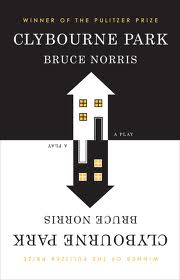 problems in their marriage. When the local pastor, Father Jim (Brendan Griffin) and concerned neighbor, Karl (Jeremy Shamos) stop by the house the true gist of the story starts to simmer at first, builds to a boil, and ends with an all out blow out. Karl is concerned that Russ has sold his house to a black family, which in his mind could drag the neighborhood’s property values down and promote white flight. Russ seems to be surprised at this news at first, having been completely hands off with the realtor who sold his home, but warms to the news in an unanticipated way. The fact is, Russ sees this as an appropriate farewell to a community he secretly loathes. Russ feels his family was treated as pariahs because his only son committed suicide after returning from the Korean War under the suspicion of war crimes.
problems in their marriage. When the local pastor, Father Jim (Brendan Griffin) and concerned neighbor, Karl (Jeremy Shamos) stop by the house the true gist of the story starts to simmer at first, builds to a boil, and ends with an all out blow out. Karl is concerned that Russ has sold his house to a black family, which in his mind could drag the neighborhood’s property values down and promote white flight. Russ seems to be surprised at this news at first, having been completely hands off with the realtor who sold his home, but warms to the news in an unanticipated way. The fact is, Russ sees this as an appropriate farewell to a community he secretly loathes. Russ feels his family was treated as pariahs because his only son committed suicide after returning from the Korean War under the suspicion of war crimes.
The African American response is provided by Francine (Chrystal Dickerson), who works for Karl and his wife as a maid, and Francine’s husband, Albert (Damon Gumpton), who has the misfortune of picking his wife up from work as this neighborly dispute erupts. When an incredulous Karl asks Francine, hypothetically speaking, if money were not an issue, whether she would like to live in Clybourne Park, Francine can only say, “It is a very nice neighborhood,” since she doesn’t want to risk offending her employers with a response they may not like. Albert, on the other hand, is more forthcoming and speaks out loud the real question being asked of them, which is: “Would we want to live next door to white people?”
Russ’s wife Bev (Kristine Clark), whose world and marriage have just imploded for all to see, desperately turns to Francine as an ally, even going so far as to call Francine a friend while embracing the woman whose look of helpless discomfort speaks volumes. Bev wonders out loud why everyone—Black and White—can’t just live together. While Bev’s sentiments fall on deaf ears, the scene dissolves into a flashback of Bev’s son in military dress uniform as he writes his suicide note to his parents.
While Act One’s intentions were crystal clear, Act Two’s message is less so.

0 Comments on
Clybourne Park Review as of 7/31/2012 12:54:00 PM

By:
Jason Low,
on 6/1/2012
Blog:
The Open Book
(
Login to Add to MyJacketFlap)
JacketFlap tags:
diversity,
politics,
sexism,
LGBT,
Educators,
society,
Native American,
African/African American Interest,
Musings & Ponderings,
Race issues,
Multiracial,
Dear Readers,
Asian/Asian American,
Latino/Hispanic/Mexican,
human-rights,
Add a tag
Throughout the history of the United States, equality for all people has been fought for and won time and time again. Thomas Jefferson wrote in the Declaration of  Independence ”that all men are created equal,” and over time equal rights have been gradually extended to different groups of people. However, equality has never been achieved without heated debate, despite our country’s founding principle that all people are created equal in the first place.
Independence ”that all men are created equal,” and over time equal rights have been gradually extended to different groups of people. However, equality has never been achieved without heated debate, despite our country’s founding principle that all people are created equal in the first place.
The language used to seek equality has remained familiar over time. Posters demanding equal rights (pictured) contain messages we have all seen or heard. One of my theories is that since the human life span is finite, the message of equality has to be relearned by each generation as it comes to realize that more work needs to be done.
If humans lived longer, would full equality across racial and gender lines have been acquired by now? Ask yourself: Would women suffragists from the 1920s, who so 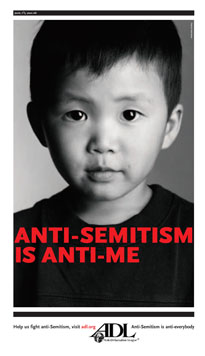 vehemently demanded the right to vote, think it was fine for African Americans to be denied this same right? It depends. My theory also includes the caveat that empathy for others does not always translate into citizens banding together for the greater good. Then again, the social evolution of the United States is progressing. This progression is the reason the language and message of equality remains relevant.
vehemently demanded the right to vote, think it was fine for African Americans to be denied this same right? It depends. My theory also includes the caveat that empathy for others does not always translate into citizens banding together for the greater good. Then again, the social evolution of the United States is progressing. This progression is the reason the language and message of equality remains relevant.
Equality is a shared goal that not everyone enjoys. Racial intolerance for one group is no different than bigotry for another. Denying equality for a particular group plays into the kind of discriminatory trap that makes no sense if one applies the very same principles of equality indiscriminately. All people are created equal, period.
The Declaration of Independence was written with the hope of possibility. Think about it—the signers of this document were declaring a new and independent country! 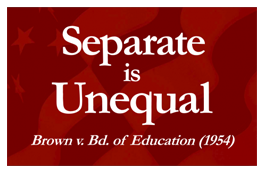 Jefferson’s words made a statement about human rights that became the foundation for a country unlike any other in the world. The signers never anticipated that their vision would eventually embrace so many different kinds of people, but that is the beauty of it. The Declaration was groundbreaking because it provided a foundation of principles and moral standards that have endured to modern times and that accommodate human evolution and its capacity for acceptance.
Jefferson’s words made a statement about human rights that became the foundation for a country unlike any other in the world. The signers never anticipated that their vision would eventually embrace so many different kinds of people, but that is the beauty of it. The Declaration was groundbreaking because it provided a foundation of principles and moral standards that have endured to modern times and that accommodate human evolution and its capacity for acceptance.
Stepping back and viewing all these posters as a whole, one could come to two conclusions. First: the human race does not learn from history. Second: humans 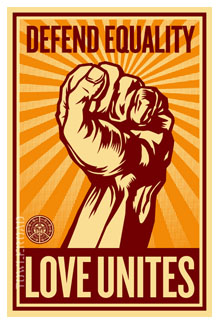 repeat the same mistakes over and over. However, I believe that the preservation and repurposing of the messages of protest in all their different forms are evidence that we do learn from history, and that we apply these tactics when the moment calls for them.
repeat the same mistakes over and over. However, I believe that the preservation and repurposing of the messages of protest in all their different forms are evidence that we do learn from history, and that we apply these tactics when the moment calls for them.
Similar to my previous posts on Race-Based Comedy and Race in Advertising, this post is a small glimpse into a bigger topic that welcomes further discussion. These subjects would be commonplace in a college syllabus, but is there any reason why we shouldn’t introduce dialogue about such issues into our daily lives? At the dinner table, instead of asking your kids how their day was at school and receiving a one-word answer, try bringing
From time to time, race issues pop up in advertising. Race is a tricky subject in advertising because common approaches tend to reinforce racial stereotypes and rub people the wrong way if not handled with care.
Sensibilities vary from city to city and from country to country. Since the United States went through the civil rights movement, many Americans are aware of race issues and may recognize on their own when people of color are depicted in an unfavorable light.

In 2010, a KFC ad ran in Australia depicting a lone white fan at a cricket game, surrounded by a rowdy bunch of black West Indians. To restore order, the white cricket fan placates the entire crowd with a bucket of fried chicken. I’ve read commentary from Australians rejecting claims that the ad perpetuates racial stereotypes, but the controversy raised enough public ire that KFC eventually pulled the ad.
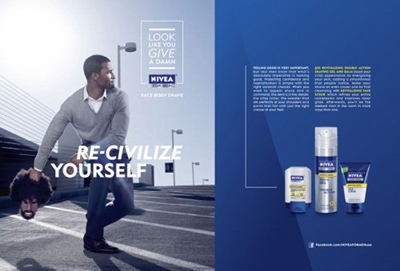
In 2011, Nivea ran an ad depicting a preppy, groomed black man holding the head of his former self, who is sporting a beard, an Afro, and an angry expression. The ad clearly conveyed a message—the idea that natural hair on a black man is uncivilized, rather than simply being a style preference or a nod to Afrocentrism. The ad was pulled and the company issued an apology.

The main goal of some political ads is to spread fear and distrust of opposing candidates by focusing on differences that can be portrayed as “anti-American.” This ad for Pete Hoekstra’s Michigan Senate run was shown during the 2012 Super Bowl. The fact that this ad encouraged xenophobia caused such outrage against Pete Hoekstra that Hoekstra’s opponent Debbie Stabenow actually saw a rush of donations to her campaign as a direct result of the ad. The ad was pulled by the Hoekstra campaign soon after.
On the other hand, many ads that feature people of color are successful:
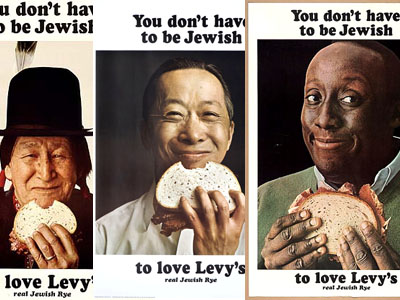
In the 1960s, Levy’s Jewish Rye ad campaign was an effort to expand the customer base of Levy’s Jewish Rye beyond the Jewish community. The ad campaign featured ordinary New Yorkers of diverse ethnic and cultural backgrounds and was groundbreaking for its inclusiveness.
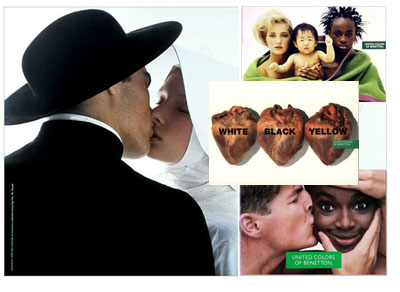
In the 1980s, the clothing company United Colors of Benetton gained a reputation for pushing the envelope in areas of race and religion with some of the most memorable ad campaigns in advertising history. I’ve heard some people complain that some Benetton ads are racist, but provocative ads are designed to test the line of what is appropriate and to make people literally stop in their tracks and take notice.

In 2000, Ca
We hope everyone had a great President’s Day! The month of February has been filled with some fascinating diversity-related stories. Here are just a few that we’ve 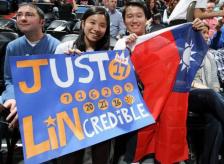 been following; if you’ve got more February news stories, feel free to share them in the comments below!
been following; if you’ve got more February news stories, feel free to share them in the comments below!
In a matter of weeks, Knicks player Jeremy Lin has gone from bench-warmer to star athlete. His incredible success on the court has prompted questions about whether his ethnicity had anything to do with his slow rise to the top as well as some interesting race-related memes. Ultimately, though, the most important aspect of this story may be that tons of people now have a great new role model.
New statistics show that interracial marriages in the US have hit an all-time high of 1 in 12 marriages. Experts attribute the rise to growing pools of Asian and Hispanic immigrants, and say the increase could lead to better racial relations long-term. “Mixed-race children have blurred America’s color line,” said Daniel Lichter, a sociology professor at Cornell University. Meanwhile, HBO gives a look at one interracial couple who fought for the right to marry.
to growing pools of Asian and Hispanic immigrants, and say the increase could lead to better racial relations long-term. “Mixed-race children have blurred America’s color line,” said Daniel Lichter, a sociology professor at Cornell University. Meanwhile, HBO gives a look at one interracial couple who fought for the right to marry.
Arizona legislators continue to push for a prohibition of “partisan doctrine” from Tuscon schools. Tuscon’s award-winning Mexican American Studies Program was recently shut down and several books used in the curriculum were removed from classrooms. Debbie Reese of American Indians in Children’s Literature has a comprehensive timeline of how things have played out here.
And of course it’s Black History Month! If you haven’t entered our giveaway yet, what are you waiting for?
Filed under:
Add a Comment
In our December e-news, we took a look at how 2011 has played out in terms of diversity with a few events of note:
Good: We started Tu Books! Which means more diversity in science fiction, fantasy, and mystery.
Authors Cindy Pon and Malinda Lo organized the Diversity in YA tour and website to highlight diverse books and authors, and got a terrific response from readers.
This year’s KidLit Con conference for children’s book bloggers included a panel on diversity. It’s a topic both readers and authors are giving real thought to.
Also, three out of this year’s four National Book Award winners are authors of color. Which means authors of color are being recognized more…
Bad: …but not necessarily published more. In an informal survey, bloggers could come up with just 84 middle grade and YA authors of color published this year.
And just plain ugly: The casting of the movie version of The Hunger Games brought out the worst in some fans, who were surprised by the inclusion of black cast members.
So, what are your highs and lows of 2011?
Filed under:
Musings & Ponderings Tagged:
diversity,
Race issues,
Teens/YA 







This past weekend some guy called me a gook. What was surprising is it happened right in my hometown. I have lived in my town for five years now and have never had any problems with racism. This came out of the blue and was totally unprovoked. I was on my way to pick up Indian takeout for my family’s dinner.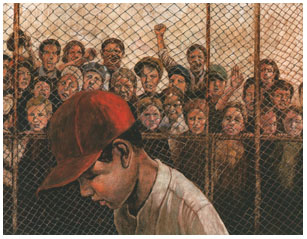
There were so many things out of the ordinary about this incident. The man who called me a gook was with his girlfriend and didn’t appear to be drunk. In the past, racist insults usually have come from groups of young men, late at night, after consuming 6+ beers each. It wasn’t late; it was around seven o’clock in the evening. And the part about the guy being with his girlfriend is significant because usually a person tries to conceal the less than desirable parts of his or her personality, like being racist, at least until after the third date.
What eats me up about this incident is that after all these years of being immersed in the diverse books we publish, all the self education I have undergone to become more culturally aware was completely useless. I was caught utterly flat-footed when it happened, with not one snappy comeback to show for myself. I stood there frozen in indecision. I did nothing. My lack of verbal Jujitsu kind of ruined my night.
I went back home with my take-out order and ate dinner with my family. I told them about the incident and we had a lively conversation consisting of woulda, coulda, shoulda scenarios and comebacks that made us all laugh. The reality is I haven’t been subjected to a racist insult in many years, which may be why this experience was so jarring and caught me off guard. The fact that the frequency of events like this has decreased so much is most likely a testament to the teaching of acceptance in our schools. I also hope that maybe the kind of books we publish are part of the solution.
You know what they say about sticks and stones. Well as an adult and parent, name calling still hurts.
Has anyone had a racist experience in the last year? If so, how did you handle it? Did you manage to fire off any memorable retorts? I need some verbal ammunition for my next trip into town.
Filed under:
Dear Readers Tagged:
diversity,
Race issues,
racism 




 10 Comments on When Racism Comes Home, last added: 11/3/2011
10 Comments on When Racism Comes Home, last added: 11/3/2011
Happy Halloween, everyone!
Some of you may have seen this new anti-racism poster campaign coming out of Ohio State University, put together by one of their student organizations:
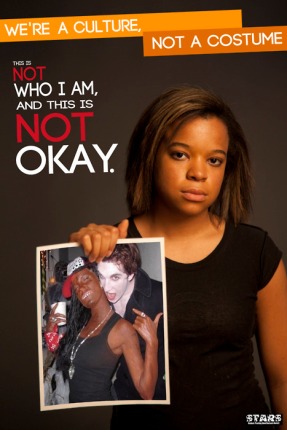
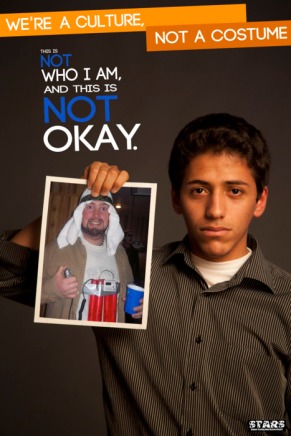
The campaign quickly went viral and has drawn national attention (along with a number of parodies). What’s good about these posters is the extensive discussions they’ve sparked around the country. Are costumes based on a stereotype inherently racist? Where is the line drawn between racism and a casual joke—and is there ever such a thing as a casual joke about race? Who gets to decide if something has crossed the line?
Some have dismissed the posters as being too sensitive and taking the fun out of Halloween. But Cherokee blogger Adrienne asks the key follow-up question: “Why does your fun have to come at the expense of my well-being?”
Meanwhile, take a look at this amazing pumpkin YA author and blogger Kate Hart carved with the cover image of Under the Mesquite:
 Gorgeous!
Gorgeous!
Happy Halloween, everyone!
Filed under:
Diversity Links,
Musings & Ponderings Tagged:
diversity,
Race issues,
Under the Mesquite 



 0 Comments on Halloween: A culture, not a costume as of 1/1/1900
0 Comments on Halloween: A culture, not a costume as of 1/1/1900


 I’d be interested in seeing how many of these top 100 grossing sci-fi and fantasy films star non-human leads. I wonder if there are more films with non-human leads than minority human leads on the list!
I’d be interested in seeing how many of these top 100 grossing sci-fi and fantasy films star non-human leads. I wonder if there are more films with non-human leads than minority human leads on the list!
 Too many wealthy, white men still run Hollywood, and their decisions still have too much power. As I mentioned earlier, these kinds of movies are very expensive, and so it’s hard for independent or upstart filmmakers to break through or compete.
Too many wealthy, white men still run Hollywood, and their decisions still have too much power. As I mentioned earlier, these kinds of movies are very expensive, and so it’s hard for independent or upstart filmmakers to break through or compete.










 Morgan Freeman) speaking American English? Sure, some of that is unavoidable and practical–you can’t make a movie about everyone and in every language at the same time–but it’s also ethnocentric and exceptionalist of us. Not to mention problematic in myriad ways, because the lack of diversity goes utterly unacknowledged.
Morgan Freeman) speaking American English? Sure, some of that is unavoidable and practical–you can’t make a movie about everyone and in every language at the same time–but it’s also ethnocentric and exceptionalist of us. Not to mention problematic in myriad ways, because the lack of diversity goes utterly unacknowledged.


 of various shades of brown, is a veritable queer utopia, and allows both its characters and its readers to grapple with complex questions about technology and ethics without coming to one conclusion. But even after making the National Book Award longlist, it was ignored by ALA in all of its awards, and it’s not getting nearly the amount of recognition it should be getting, neither for its literary quality nor for its progressive strides.
of various shades of brown, is a veritable queer utopia, and allows both its characters and its readers to grapple with complex questions about technology and ethics without coming to one conclusion. But even after making the National Book Award longlist, it was ignored by ALA in all of its awards, and it’s not getting nearly the amount of recognition it should be getting, neither for its literary quality nor for its progressive strides.





























 problems in their marriage. When the local pastor, Father Jim (Brendan Griffin) and concerned neighbor, Karl (Jeremy Shamos) stop by the house the true gist of the story starts to simmer at first, builds to a boil, and ends with an all out blow out. Karl is concerned that Russ has sold his house to a black family, which in his mind could drag the neighborhood’s property values down and promote white flight. Russ seems to be surprised at this news at first, having been completely hands off with the realtor who sold his home, but warms to the news in an unanticipated way. The fact is, Russ sees this as an appropriate farewell to a community he secretly loathes. Russ feels his family was treated as pariahs because his only son committed suicide after returning from the Korean War under the suspicion of war crimes.
problems in their marriage. When the local pastor, Father Jim (Brendan Griffin) and concerned neighbor, Karl (Jeremy Shamos) stop by the house the true gist of the story starts to simmer at first, builds to a boil, and ends with an all out blow out. Karl is concerned that Russ has sold his house to a black family, which in his mind could drag the neighborhood’s property values down and promote white flight. Russ seems to be surprised at this news at first, having been completely hands off with the realtor who sold his home, but warms to the news in an unanticipated way. The fact is, Russ sees this as an appropriate farewell to a community he secretly loathes. Russ feels his family was treated as pariahs because his only son committed suicide after returning from the Korean War under the suspicion of war crimes. Independence ”that all men are created equal,” and over time equal rights have been gradually extended to different groups of people. However, equality has never been achieved without heated debate, despite our country’s founding principle that all people are created equal in the first place.
Independence ”that all men are created equal,” and over time equal rights have been gradually extended to different groups of people. However, equality has never been achieved without heated debate, despite our country’s founding principle that all people are created equal in the first place. vehemently demanded the right to vote, think it was fine for African Americans to be denied this same right? It depends. My theory also includes the caveat that empathy for others does not always translate into citizens banding together for the greater good. Then again, the social evolution of the United States is progressing. This progression is the reason the language and message of equality remains relevant.
vehemently demanded the right to vote, think it was fine for African Americans to be denied this same right? It depends. My theory also includes the caveat that empathy for others does not always translate into citizens banding together for the greater good. Then again, the social evolution of the United States is progressing. This progression is the reason the language and message of equality remains relevant. Jefferson’s words made a statement about human rights that became the foundation for a country unlike any other in the world. The signers never anticipated that their vision would eventually embrace so many different kinds of people, but that is the beauty of it. The Declaration was groundbreaking because it provided a foundation of principles and moral standards that have endured to modern times and that accommodate human evolution and its capacity for acceptance.
Jefferson’s words made a statement about human rights that became the foundation for a country unlike any other in the world. The signers never anticipated that their vision would eventually embrace so many different kinds of people, but that is the beauty of it. The Declaration was groundbreaking because it provided a foundation of principles and moral standards that have endured to modern times and that accommodate human evolution and its capacity for acceptance. repeat the same mistakes over and over. However, I believe that the preservation and repurposing of the messages of protest in all their different forms are evidence that we do learn from history, and that we apply these tactics when the moment calls for them.
repeat the same mistakes over and over. However, I believe that the preservation and repurposing of the messages of protest in all their different forms are evidence that we do learn from history, and that we apply these tactics when the moment calls for them.












Wow, this is depressing. 6 of 8 are Will Smith… It’s really hard to surprise me with bad diversity news out of Hollywood, but that did.
Great job as usual, Lee and Low team!